The Transfigured Guitar of Alberto Ginastera
Sonata for Guitar, op. 47

-
Format: Exposition
-
Full name: Silvia Escamilla Jiménez
-
Main Subject: Classical Guitar
-
Student Number: 3322661
-
Date: 21-02-2022
-
Research Question: 'How and to what extent did Ginastera combine avant-garde composition techniques with Argentinian folkloristic elements?’
-
Research Supervisor: Enno Voorhorst
-
Master Circle Leader: Bart van Oort
-
Main Subject Teacher: Pavel Steidl
Table of Contents
-
Abstract
-
Introduction
2.1. Justification and Objectives
2.2. Methodology
-
Alberto Ginastera and the guitar: trajectory, aesthetic and composicional resources
3.1 First Period: Objective Nationalism (1934-1947)
3.2 Second Period: Subjective Nationalism (1947-1957)
3.3 Third Period: Neo-expressionism (1958-1983)
-
Introduction to Argentine Folklore
-
Folklore on the Sonata for Guitar, op. 47: Analysis
5.1 “Esordio”
5.2 “Scherzo”
5.3 “Canto”
5.4 “Finale”
-
Comparasion of compositional resources: String Quartet no. 1, op. 20 (1948)
-
Conclusion
-
Bibliography
1. Abstract
This research project takes as a starting point the Ginastera’s Sonata for Guitar. This Sonata is a very interesting work because of the way in which the composer mixes typical avant-garde compositional techniques, such as serialism or twelve-tone technique, with folklore rhythms and popular elements typical of Argentine traditional music. Discovering the origin of the thematic and rhythm sources of the Sonata for Guitar, op. 47 by Alberto Ginastera is an invitation to inquire in the valuable atmosphere of the Argentine folklore. Finally, this research presents some connections between this guitar piece and the String Quartet no. 1, op. 20, that Ginastera composed more than twenty years before.
2. Introduction
2.1. Justification and objectives
The demand for this Sonata requires both a special dedication to its technical and mechanical study as well as to its theoretical musical understanding: it behooves combining two capacities, analytical and executive, in the same project, which have sometimes been presented as independent processes. Consciously identifying these tasks, researching them, deciding on precise methods of analysis, ordering the processes and systematizing them when possible to finally express them in writing, has been the objective of this work. Achieving a valid, sincere and consistent interpretation of this analysis would be the ultimate goal.
Precisely, the English tenor Ian Bostridge, in his book Schubert´s “Winter’s Journey”: Anatomy of an Obsession[1], recounts in its pages the hard previous work of investigation and introspection that he has undertaken before facing the interpretation of the work. It includes technical texts, poems, illustrations, memories and experiences to the point that it is more like a not very systematic exploration of his own life than a musicological analysis of the work that he intends to interpret. Also John Rink in his article “Analysis and (or?) Interpretation”[2] comments that in the decision-making process of a performer there is always an analysis —even if it is intuitive or piecemeal— of the work. In other words, it would be a matter of discovering and understanding the hidden mechanism that the composer has put into operation in his composition and then being able to explain it to an audience. In an interview with Glenn Gould, on the occasion of his last recording of the Goldberg Variations, he was asked how many hours he spent in rehearsal sitting at the piano, to which he replied that very few. The bulk of his work was basically mental and consisted of methodically studying the score, and he did not begin to play until he was completely clear about the intention and the musical direction that he wanted to give to the work. But, it is emphasised, rather than insist on the descriptive analysis of the work —which is also necessary— what is really interesting to point out is precisely the consequences or interpretative repercussions of those same analytical conclusions.
To develop the research topic of this project it is necessary to establish a research question and others derived from this, that may be useful and helpful to specify and guide the information:
-
How and to what extent did Ginastera combine avant-garde composition techniques with Argentinian folkloristic elements?
-
Can we consider the guitar as the main symbol of popular music? How does this influence the development of the avant-garde?
-
How the popular music and avant-garde compositional techniques complement each other? What is the result of this collaboration in Alberto Ginastera’s Sonata for guitar?
-
What elements of Argentine folklore can we find in the Sonata for guitar composed by Alberto Ginastera?
-
Which contemporary music compositional elements (twelve-tone and serialism) Alberto Ginastera uses in the Sonata for Guitar? And where?
-
How can we understand the term “nationalism” in Alberto Ginastera’s work?
-
In what way it can be found the guitar as a symbol in Ginastera’s work and in the Sonata for guitar itself?
-
Based on these established questions the main objectives in this research project will be look for how is found the representation of the guitar as a symbol, in the guitar Sonata itself: how the old creole guitar, present in its rhetoric and symbolically evoked, is transformed into a reality . One of the main sources of inspiration for Ginastera’s work is the folklore music of his birthplace, and the guitar is one of the most representative symbols of Argentine folklore. On the other hand, to be able to contrast the information and justify these ideas, the String Quartet no. 1 will be analyzed and compared to the Sonata[3] [4].
2.2 Methodology
This research work is presented in two clearly differentiated parts. In the first of them, an initial task of gathering information and preparing a synthesis of the most significant aspects of musical production and the aesthetic approaches of Alberto Ginastera’s work has seemed essential in order to contextualize, within a personal trajectory and the history of contemporary music, what will be the focus of interest of the second part of the work: the analysis and comparison of the Sonata for Guitar and the String Quartet.
Depending on the compositional style, technique and elements that appear in this work, various analysis methodologies will be used.
The repertoire of atonal music is characterized by the appearance of sounds in novel combinations, as well as by the appearance of combinations of familiar sounds in unfamiliar environments.[5] The twelve-tone system has been used on a number of occasions. In this compositional technic, 12 pitch classes will have an ordered arrangement, with each one occurring only once. This will conform the tone row: the core of the system. Four basic forms of the row can be distinguished, Prime (“P”, original set), Retrograde (“R”, the original set in reverse order), Inversion (“I”, the mirror inversion of the original set) and the Retrograde Inversion (“RI”, the inversion in reverse order) [6]. The tone row has 48 versions, since each basic form can be transposed 12 times. The Matrix will be used in order to visualize all this 28 versions. (See matrix 1. Chapter 5.2 “Scherzo”)
It is not surprising that the analysis of atonal music has required the development of new theoretical terms and approaches. In the absence of analytical models in traditional music theory that respond to unusual peculiarities of these creations, the Set Theory[7] establishes a method based on the analysis and comparison of the relationships between groups of notes (sets), based on transpositions or inversions.
The pitch aspect of atonal music required a new terminology. To this new way of presenting motives was given various names as cell, basic cell, set, pitch (concrete individual height), pitch class (set of all the pitches of any name in any octave), pitch interval (specific interval in number of semitones), pitch-class set (set of pitches of 3-9 sounds), … This can be presented melodically, harmonically, or as a combination of the two of them. The pitches can appear in any order and the set can also be transposed or inverted. An atonal melodic fragment or chord can consists of any combination of pitches. To be able to compare this sets, Allen Fortes’s labelling work is very useful, and his system of pitch class sets reduces this number considerably.
To analyze and compare the pitch-class sets in atonal music, a process is needed that will reduce any set to some basic form. In this Theory, each one of the notes of the chromatic scale is given a relative numbering, since the absolute pitch, which is used as a unit of information, is not taken into account. (Image 1, letters “T” and “E” refers to numbers ten and eleven respectively to avoid ambiguity).

Image 1. Relative Numbering Set Theory. [8]
In the analysis process, the first thing is to eliminate the repeated notes of the fragment. The second step is to organize them from the lowest to the highest in order to reduce the range. Finally, the “Normal Order” will be obtained. The “Prime form” of the set will be the compact order of the pitches. From here, a numeric combination will be taken, to enable the comparation of fragment intervalic.(Image 2) [9]

Image 2. Example Relative Numbering Set Theory and “Prime Form” number.
The “Forte Name” will be obtained after the analysis of the pitch class set; the first number specifies the number of pitches, while the second one corresponds with the number given by the author, Allen Forte, in a table showed in his book referred before. It is important to comment that in some sets, the letter “Z” is included in the “Forte name”. This happens when the sets has another par related, i.e, that contains the same intervalic vectors but cannot be reduced to the same prime form. The intervalic vector shows the amount of intervals of each type that are included in one set. [10]
George Perle in “Pitch-class Set Analysis: An evaluation” [11] criticizes in a certain way these principles of analysis formulated by Allen Forte. It raises the fundamental problem that the relationships established between sets ignore compositional dimensions, although on the other hand, this does not mean that it rejects the notion that pitch-class sets exist: “It is only when one defines everything in terms of pitch-class sets that the concept is meaningless”. (Perle, 67).[12]
In accordance with the previous statement, the analysis should be completed with more traditional models, in order to not stop considering aspects that are fundamental, such as tonal references, dynamics, timbral, rhythmic, formal aspects and even intertextuality and musical references, or musical quotes, that will be significant to understand the chosen piece and prepare the interpretation. To sum up, the main intention is to investigate how the popular music and avant-garde compositional techniques complement each other and the result of this collaboration.
In regard to the general study of the composer, all Ginastera’s research works take as a starting point the studies of his student Pola Suárez Uturbey in the 1970s, such as the essential Ginastera en cinco movimientos (1972),[13] which includes, among other interesting aspects, talks, interviews and first-hand notes that are considered very valuable.
The most recent and complete general works are due to Professor Deborah Schwartz-Kates; her book Alberto Ginastera: A Research and Information Guide (2010)[14] has become the mandatory manual for any specific and detailed information about our author. Since 1990, a large number of articles in specialized journals, monographs and doctoral theses on specific aspects of his work have proliferated, both in Argentine academic circles and in other areas, a circumstance that allows us to confirm the growing interest that arouses both his personality and the creations he has left us.
3. Alberto Ginastera and the guitar: trajectory, aesthetic and composicional resources.
The Sonata for Guitar, op. 47 (1976) is one of the last works of the Argentinian composer Alberto Ginastera (Buenos Aires, April 11, 1916 – Geneva, June 25, 1983) and the only one for this instrument, within an extensive production which includes three operas, two ballets, pieces for orchestra —with and without soloist—, voice, chamber ensembles, works for piano, harp, for cello and other instruments, incidental music for cinema and theater pieces, etc.
Ginastera repeatedly stated that his musical career was a succession of different stages, which he himself called objective nationalism, subjective nationalism and neo-expressionism. But at the end of his career he came to realize that in reality the history of his musical production could not be described as three overly compartmentalized stages, but that it was the result of a slow evolution, without too many radical changes, and that the compositional cycles he had been proposing earlier were not so different in their approach.
Indeed, in each period of his musical production there are common impulses that, with more or less intensity, try to maintain a dynamic balance and in which constantly intersect, on the one hand, the desire to find his own voice, a personal identity, but, on the other hand, a receptive attitude to new concepts of music that come from abroad. Two of these impulses will be outlined; one that for the moment it has been called the search for Argentine musical constants, and the other that has to do with the consciously renovating character of his music.
In his compositions, the recognition of the identity of traditional Argentinean music is marked even in the title of his early works —as in his three Danzas argentinas from 1937: “Del viejo boyero”, “De la moza donosa” and “Del gaucho matrero”, or in his Pampeanas (1947, 1950 and 1954)— but in perceiving this music it can be identified more a personal style than a national stereotype, which sometimes unfairly and wrongly has been reduced to the porteño music and tango universalised by Carlos Gardel (1890 or 1887-1935). This is not what is found in Ginastera. To perceive the presence of Argentine folklore in his music, as it will be shown in the analysis, a process of deconstruction will be necessary to find it fused with other musical elements. In the same way, as time goes by, it can also be perceived in the Argentinean author a process of permeability and geographical openness that lead him towards a musical Pan-Americanism where he also incorporates sonorities from other countries.
The search for his own voice and his restless musical personality also led him to be constantly attentive to the avant-garde compositional novelties that came essentially from Europe, specifically the atonal language, twelve-tone technique and serialism. Ginastera’s compositional procedures, as he himself confirmed, are influenced by the systems of Bartók, Stravinsky or Alban Berg, adapting their techniques in a personal language. In Ginastera’s own words in an interview with Malena Kuss, “In the use of the twelve-note method of composition, I follow Berg’s way, not Schoenberg’s or Webern’s, because I conceive the series as a theme and I construct it thinking of its thematic potential”. With this statement is understood that the compositional approach of serialism and twelve-tone technique does not entirely regulate the works or their structure, but tries to exploit the motivic and expressive potential of the series until they cease to fulfill their function.
The presence of the guitar in Ginastera’s work is not limited to his Sonata. The prominence of the guitar in the development of Argentine folklore in the 19th and 20th centuries made it take on the symbolic meaning of a musical emblem, but, paradoxically, the instrument had not received the necessary attention from the main so-called Argentine nationalist composers, and the repertoire of works they have left as a solo instrument is not very extensive. However, this does not mean that the guitar suffered a total exclusion, because what is more frequent is to find echoes of popular guitar rhetoric in numerous melodic, harmonic or rhythmic sequences, mostly linked to works that evoke popular or costumbrist themes. For this case in particular, Ginastera had been using as a symbolic chord, the one produced by the tuning of the guitar with the open strings (E-A-D-G-B-E) to form harmonies and accompaniments since his early works, especially those for piano, as in Danzas argentinas, op. 2 (1937), through the Pampeana no. 1, op. 16 (1947) or Variaciones concertantes, op. 23 (1953) and, finally, Sonata for Piano no. 3, op. 54 —his last work— to include examples from different periods. Nor was Ginastera the only composer to have been seduced by this chord. Its presence in the impressionist aesthetics and in the harmonic development of Claude Debussy (1862-1918) has been pointed out on numerous occasions, to the point that Manuel de Falla decided to use the guitar in his Hommage[15] to the French composer with Le Tombeau de Debussy (1920).
As is already known, a large part of the repertoire for guitar composed in the 20th century has been created thanks to the various collaborations, which were sometimes express and insistent requests, that the guitarist Andrés Segovia (1893-1987) obtained from prestigious composers of contemporary classical music. In his efforts to provide the guitar with a quality repertoire and to disseminate its capabilities as an instrument, the result of this extensive collaboration is what is called the “Segovian Repertoire”, where can be found works by Heitor Villa-lobos, Manuel María Ponce, Mario Castelnuovo-Tedesco, Alexandre Tansman, John W. Duarte, or, in Spain, Federico Moreno Torroba, Federico Mompou, Joaquín Turina, Óscar Esplá, Antón García Abril or Ernesto Halfter, among others. It must be clarifyed, first of all, that Ginastera’s Sonata does not belong to the aforementioned repertoire, so it is necessary to look for other indicators that historically contextualize the work.
Finally, it should be pointed out that the guitar, as an instrument, has not remained on the border of contemporary or avant-garde developments in terms of compositional or performance techniques. Its qualities as a chordophone instrument and its classical playing technique have been enriched with new possibilities and alterations to its conventional use. Percussive sounds on different points of the body, which widened its timbre range, rasgueado on the headstock… resources that were used, in addition to Ginastera, by Leo Brouwer (1939), especially, or Hans Werner Henze (1926-2012) in his Royal Winter Music I and II (1976 and 1979), for example.
3.1 First Period: Objective Nationalism (1934-1947)
From the beginning of this period there is a clear and constant presence of elements of traditional Argentine folklore, both in rhythms and melodies —Impresiones de la puna (1934), Danzas argentinas, op. 2, for piano (1937)— which he usually integrates into impressionist textures that evoke birdsongs or sounds of nature —Panambí, op. 1 (1934-1937), whose meaning is butterfly in Guarani—, and with a growing presence of the percussion section that serves as a contrast. Conscious Ginastera of wanting to incorporate a renovating character to his music, he leans towards a clear influence of Debussy and Stravinsky’s early days, a return to the mysterious rhythms of nature, while the resonances of post-romanticism are scarce or ignored, especially those linked to Wagner or Germanism, which he will return to later. (Audio Example 1).
Audio Example 1: Alberto Ginastera Danzas argentinas, op. 2: “I. Danza del viejo boyero” (Animato e allegro), Martha Argerich, Live From the Concertgebouw 1978 & 1979.
3.2 Second Period: Subjective Nationalism (1947-1957)
After the Second World War and after the purges for political reasons in some institutions that were caused by the coming to power of Juan Domingo Perón, Ginastera moved to the United States. There he has the opportunity to meet Aaron Copland, who introduces him to the world of film music and broadens his field of aesthetic affinities. In this second period we observe more advanced techniques of atonal language such as serialism or twelve-tone. However, these compositional techniques will not regulate the structure of the piece, but will always make them compatible with the harmonies of thirds or fourths typical of Argentine folklore or the sound of the guitar. In his new compositions —Pampeana no. 1, String Quartet no. 1 (1948), Piano Sonata no. 1 (1952)— an evolution is really observed since its first period where the two tendencies that it has been pointed out, nationalism and avant-garde, reach a greater grade of harmonization and where it is sometimes impossible to identify them individually. He achieves in his music a synthesis that fuses indigenous and foreign elements, in a work that is reminiscent of that undertaken by the Hungarian musician Bela Bartók (1881-1945). Already in the 1950s, he introduced the techniques of integral serialism in Pampeana no. 3, (1954; revised 1967) and in the Harp Concerto, op. 25 (1956; revised 1968). (Audio Example 2)
Audio Example 2: Alberto Ginastera, Harp Concerto (1956), Mexico City Philharmonic Orchestra conducted Enrique Batiz.
3.3 Third Period: Neo-expressionism (1958-1983)
This period of search for a more personal style coincides with the organization of two important cultural projects: the creation of the Faculty of Music of the Argentine Catholic University, in 1958, and the direction of the Latin American Center for Advanced Musical Studies, in 1963. Both Institutions facilitated the meeting of young Latin American musicians with some of the composers of the European avant-garde, such as Olivier Messiaen (1908-1992), Iannis Xenakis (1922-2000) or Luis de Pablo (1930). Ginastera’s music embarks on a new path of experimentation with the avant-gardes (twelve-tone technique, serialism, magical surrealism, primitivism) while his style is dominated by an energetic, expressive, dramatic rhythm as we see in the opera Don Rodrigo, op . 31 (1963) or the work for soprano and orchestra consisting of fifty-two percussion instruments Cantata para América Magica, op. 27 (1960), based on pre-Columbian texts. The Cantata with an intensely dramatic vocal line is based on polyrhythmic structures and irregular meters that give it a primitive character. Again these elements reappear in his controversial opera Bomarzo, op. 34 (1966), released the following year in Washington, but censored in Buenos Aires on the pretext of attacking morality and public decency. The libretto is based on the homonymous novel by his compatriot Manuel Mujica Lainez. The work, which does not follow a classical narrative arrangement with presentation, middle and end, is structured in two acts with fifteen scenes, and, as on previous occasions, percussion continues to play a prominent role. The presence of a choir that dialogues with the protagonist and intervenes with unpredictable passages gives this opera a character of Greek tragedy.
The last twelve years of his life, between 1971 and 1983, were spent in Switzerland where he settled with his wife, the Argentine cellist Aurora Nátola. From this last stage, to which the Sonata for Guitar belongs, it is highlighted his special dedication to works for cello, either by reviewing some pieces already released, such as the Cello Concerto no. 1, op. 36 of 1968, revised in 1978, or recreating others, as can be seen in the thematic and structural correspondences between La Pampeana no. 2, from 1950, and the Sonata for Cello and Piano, op. 49, 1979. After his death, some of his projects remained unfinished, such as what would have been his fourth opera, Barrabás, with a libretto by the novelist Camilo José Cela.
4. Introduction to Argentine Folklore
It will be necessary to show a contextualisation and a brief summary of the most characteristic elements of Argentine Folklore in order to understand and assimilate not only the materials that will be shown in the analysis but also the composer’s compositional imaginary.
In his Sonata for Guitar and in Ginastera’s works it will be found elements emanating from the style and technics of folk music guitarist, specific features of the music of South American Indian tribes and of indigenous derivation, and also specific rhythms and harmonies of folk dances. At this point it is not possible to present the numerous studies on the origins of traditional music in Argentina or to discuss which features characterize or delimit the fields of popular, rural, local, regional, national, indigenous and so-called folk music [16]. In fact, the studies commonly cited as most relevant in this matter —starting from the research of the musicologist Carlos Vega (1898-1966) and the creation of the Instituto Nacional de Musicología (1931)— tend to be rather restrictive in this sense, sometimes leaving out precisely those musical realities that still play a decisive role in the history of Argentine culture.
In a broad sense, here it can be included both regional music of indigenous origin from the northern areas, the coast or the Pampa and Patagonia, as well as later manifestations of Spanish colonial origin, Creole or other roots originating from the various waves of European emigration (it can be recalled here, for example, the German origin of the accordion, the harmonica or the Rio de la Plata bandoneon), without forgetting also the clear permeability to the music of bordering countries such as Uruguay, Brazil, Paraguay, Bolivia and Chile. Nor should it be forgotten the development of popular music in urban areas and therefore include tango and all its varieties.
As throughout the 20th century, at present, traditional and folkloric music in Argentina continues to develop and is not immune to the process of fusion with other musics. Native instruments, such as those originating in the Andean region of the Quechua culture (bone or ceramic ocarina, siku, quena, erque, pincullu, caja, etc.) are mixed with others and accompany songs such as the Vidala, the tonada, the baguala or the vidalita. African roots can also be perceived in other Creole rhythms and dances such as the candombe, the escondido, the chacarera, the cueca, the zamba, the milonga, the malambo or the gato. For the topic under discussion, it is necessary to point out the strong Spanish colonial influence and how it left its traces in the diffusion of the Creole guitar, the bombo legüero or the charango, which were quickly added to the group of accompanying instruments, both for singing and for dances, to the point of acquiring prominence and displacing or supplanting the autochthonous instruments. (Audio example video 3, 4, 5).
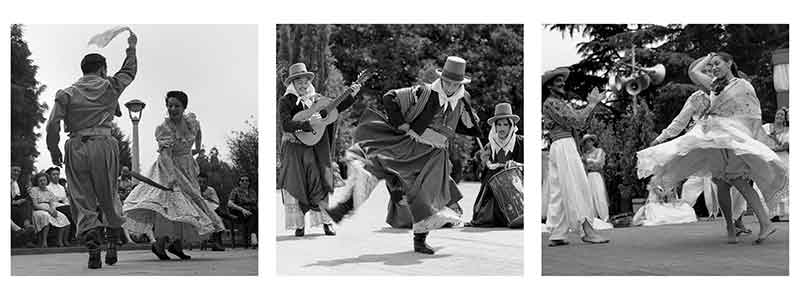
Image 3. Argentine Folk Dances. Photos by Annemarie Heinrich.
Audio example and video 3: Argentinian folk dance, Malambo.
Audio example and video 4: Argentinian folk , Milonga, “Milonga Perdida”, Atahualpa Yupanki.
Audio example and video 5: Argentinian folk , Vidala, “Argentina and Roots of European Baroque”, Bach Consort Vienna.
5. Folklore on the Sonata for Guitar, op. 47: Analysis
Following the catalog of his works established by Deborah Schwartz-Kates[17], a manuscript and two editions edited by Carlos Barbosa-Lima and revised by Ginastera himself are found. The first edition reflects the revisions of 1976-1977 and the second one, the revisions of 1981. This Sonata reveals a certain collaboration between the composer and the performer, which is why the contribution of Carlos Barbosa-Lima is considered essential in the final result of the piece. For these reasons, the second edition has been chosen for the analysis[18] and not the original manuscript.
According to Carlos Barbosa-Lima in an interview[19], Ginastera defined his Sonata as a “fusion of classical with popular styles.” This is reflected in the title of the work itself: Sonata. In the 20th century, after the Second World War, there was a dissolution and a strong break with the traditional elements that made up the musical composition, such as melody, counterpoint and harmony. Faced with this innovation and the disappearance of certain fundamental music schemes, it was necessary to find new systems of structural organization. Sometimes forms from the past were used to provide balance, cohesion and coherence to new compositions. Ginastera adopted the term Sonata to name his work, although it has little to do with the predetermined model of the past, however, they share a common characteristic: it is written in various movements. For Ginastera “a work without form is a deformed work,” therefore, that the classical form of the sonata was “the perfect home for strong musical contrasts.”[20] In this section the following aspects will be analyzed: the formal structure of the work and the movements that integrates it, the compositional elements of Ginastera that has been presented above and the folkloric elements to which it refers.
Throughout the Sonata, various compositional techniques are used, such as serialism or twelve-tone technique, all of which are impregnated with Argentine folklore. Although this work is not a tonal piece, it does not fail to preserve some references and tonal trends, especially regarding the harmonic links, harmonic tension and interval relationships.
The Sonata is divided into four contrasting movements: “Esordio”, “Scherzo”, “Canto” and “Finale”.
Before beginning the detailed and analysis of each of the four movements that make up the Sonata, some diagrams will be presented — inspired by John Rink’s “Analysis and (or?) interpretation”— in order to visualize the general lines of fluctuations of tempo and dynamics that intertwine in each movement of this work in a joint and synchronous way. The fundamental purpose of these diagrams is not to evaluate structures or to describe analytically and with rigorous precision these processes inherent in every musical composition, but rather to be a road map or visual guide to help the performers to understand the general tendencies that dominate and control the Sonata and to help them to make decisions beyond the merely intuitive ones.
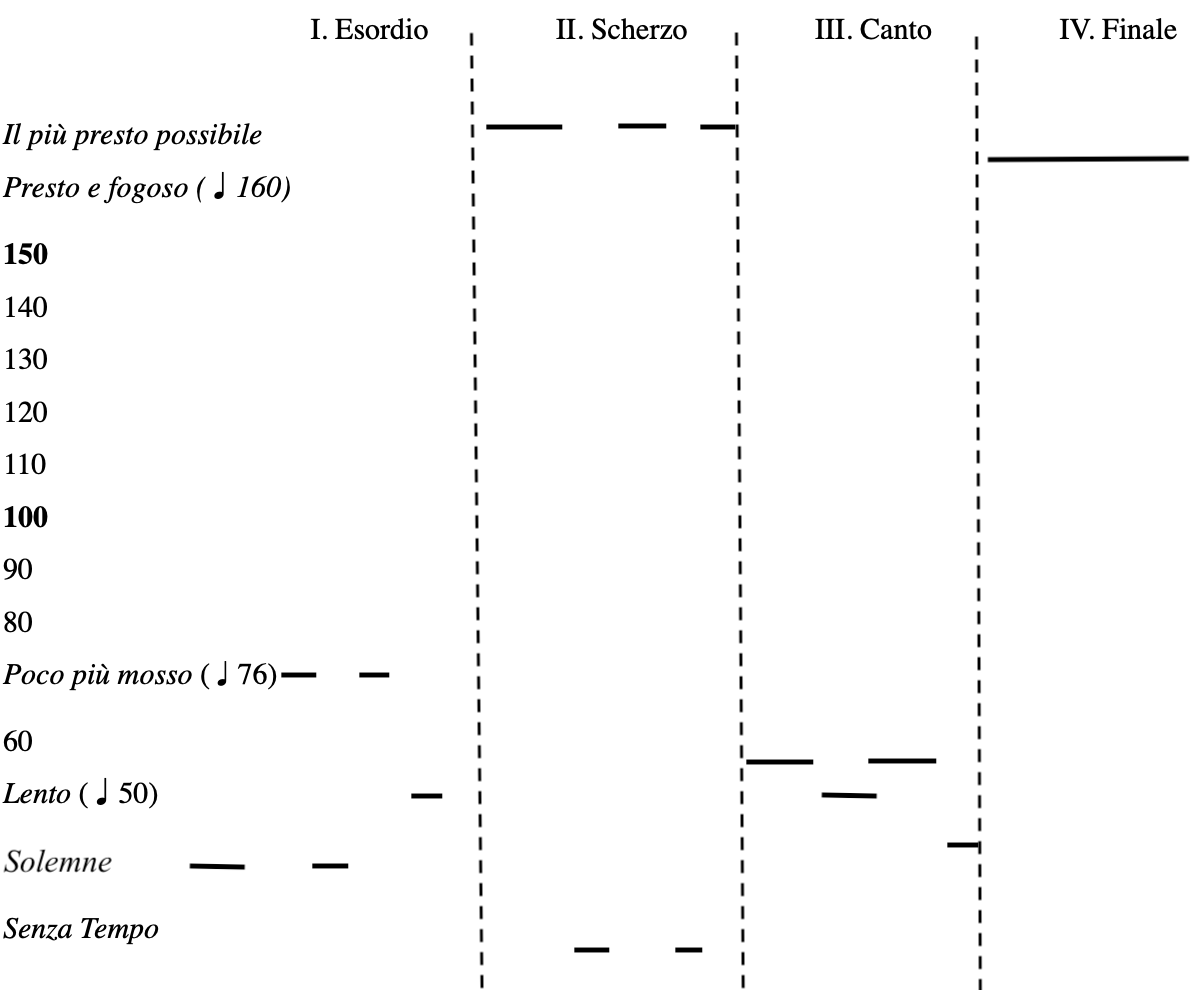
Diagram 1: Tempo fluctuations in the Sonata for Guitar, op. 47 of Ginastera
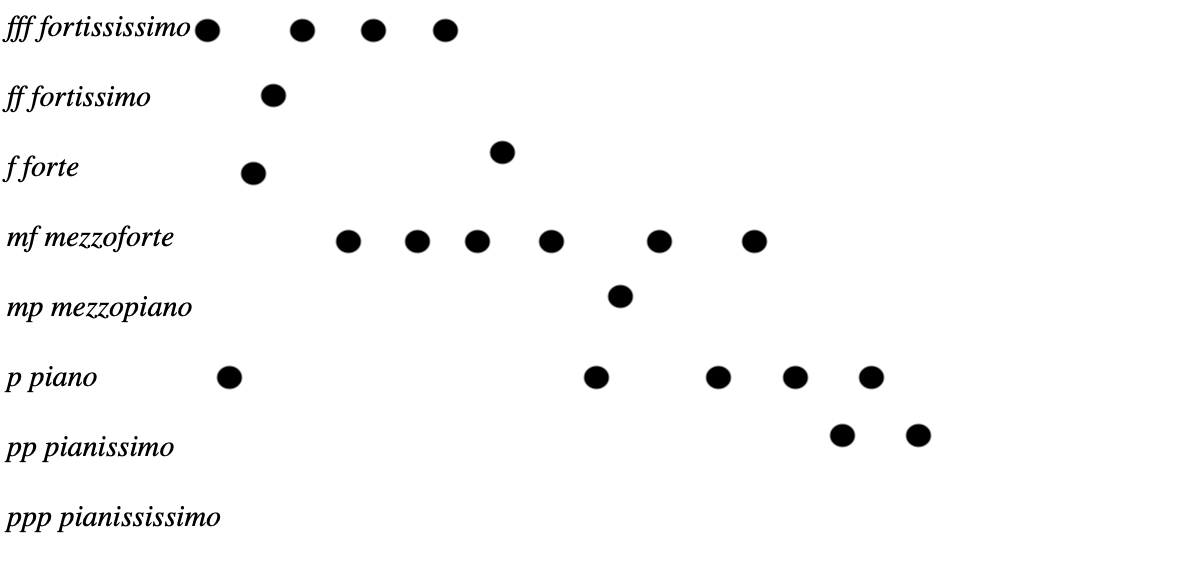
Diagram 2: Dynamic fluctuations of the Sonata for Guitar, op. 47 of Ginastera, “Esordio”

Diagram 3: Dynamic fluctuations of the Sonata for Guitar, op. 47 of Ginastera, “Scherzo”
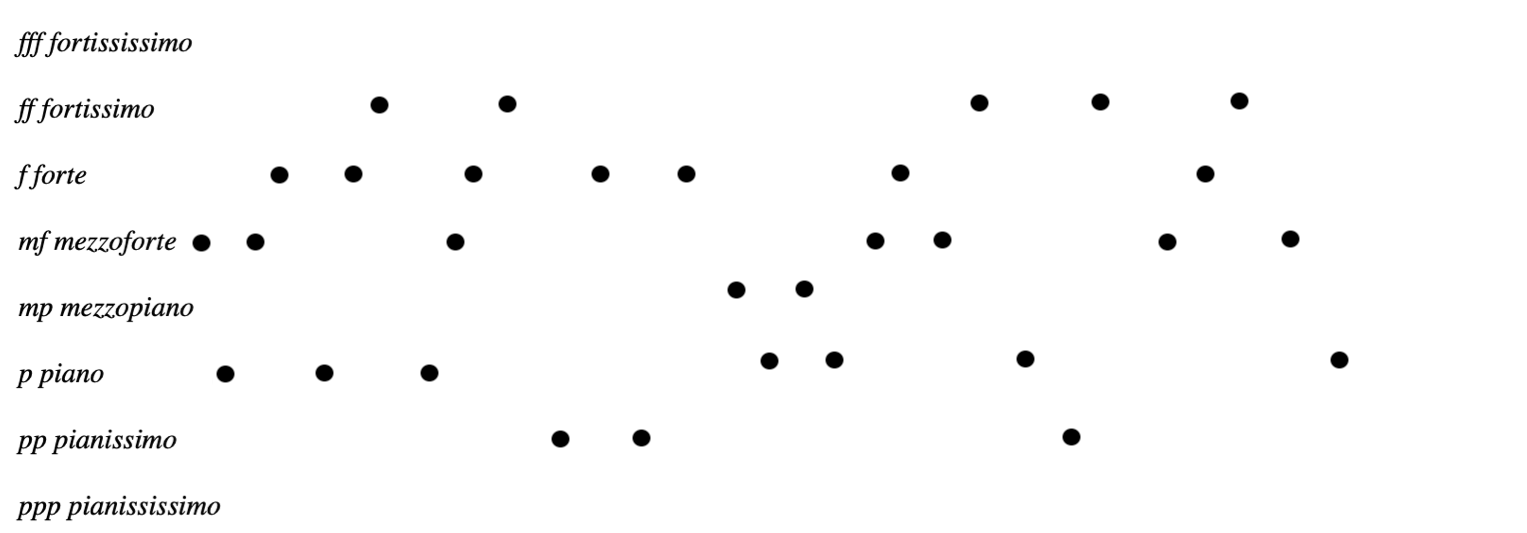
Diagram 4: Dynamic fluctuations of the Sonata for Guitar, op. 47 of Ginastera, “Canto”
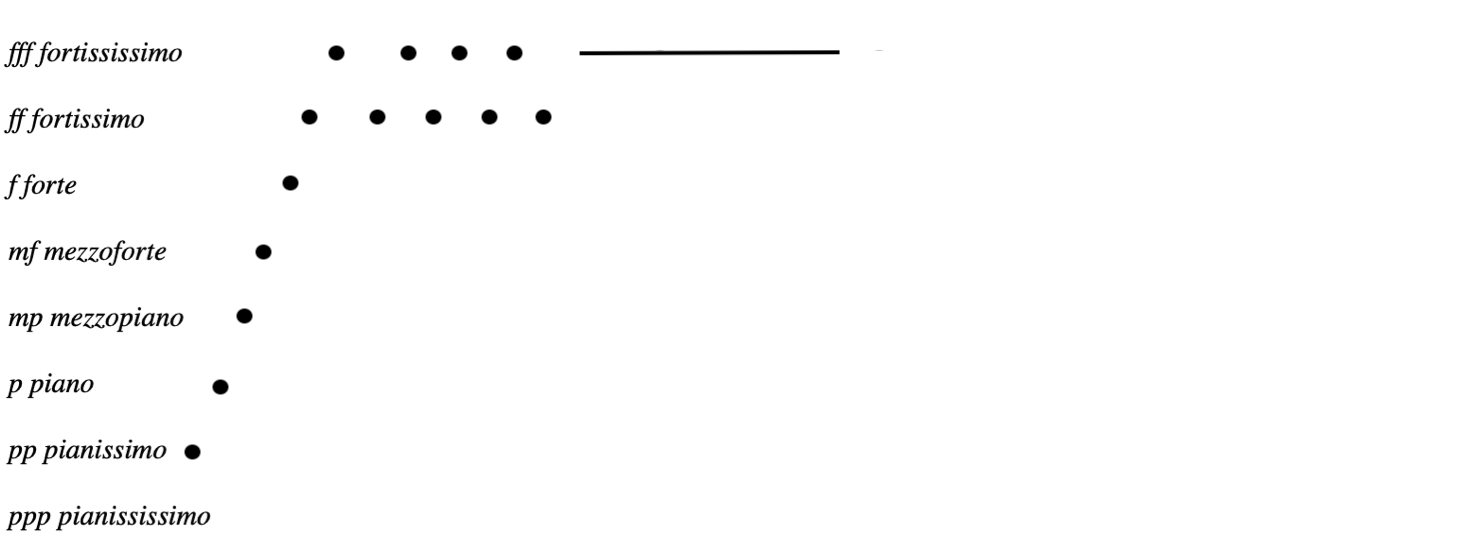
Diagram 5: Dynamics of the Sonata for Guitar, op. 47 of Ginastera, “Finale”
Ginastera calibrates the tempo of each of the movements and their respective sections with metronome-like precision and thus avoids the subjective temptation of the performer to wander at whim in the unstable margins of the andante, moderato or allegro. The tempo range in the Sonata is from the Solenne (46) which opens the first movement, through the Il più presto possibile (144) of the second, then slowing to Rhapsodic (54) in the third, and finally concluding with a dynamic Presto y fogoso (160) throughout the fourth and last movement.
The precise dynamic annotations and the numerous indications of playing nuances and intensity conduction —both with regulation signs, terms and abbreviations— also give an idea of the detailed technical control that the composer demands not only from the performer, but also from the instrument. From the fortississimo of the opening chords of the “Esordio”— which involves all the strings of the guitar and continues in a sempre tutta forza! scale— to the conclusion of this same movement in a fade-out with a final pianissimo, a previously meditated mastery is required of where the flows of energy are directed, how they contrast with each other and what their significance is. In this sense, the minimal description it has been given and a simple glance at the graphics is enough to generate the idea from the outset of one of the constants that articulates the main sense of Ginastera’s work, which consists of presenting a proposal that moves preferably within the regions of the extreme limits, in this case of tempo and dynamics, but which, as it has been already anticipated, will also extend to all the components of musical language within its reach. But, in addition, these same schemes can serve as a support for us to confirm another possible underlying structure in the work that goes beyond a simple succession of contrasting movements inspired by sonata form. (Audio and Video Example 5)
Audio and Video Example 6, Alberto Ginastera, Sonata op. 47, Sabrina Vlaskalic, 2017.
5.1 "Esordio"
“The first movement, Esordio, is a solemn prelude, followed by a song which was inspired by Kecua music and which finds its collusion in an abbreviated repetition of these two elements.” (Ginastera 1984, I)
The word “esordio” comes from Italian, it means beginning, the outset. As Ginastera describes in the foreword to the edition, cited above, this first movement is divided into two contrasting parts and ends with a re-exposition that syncretizes them. (Structure Scheme 1).
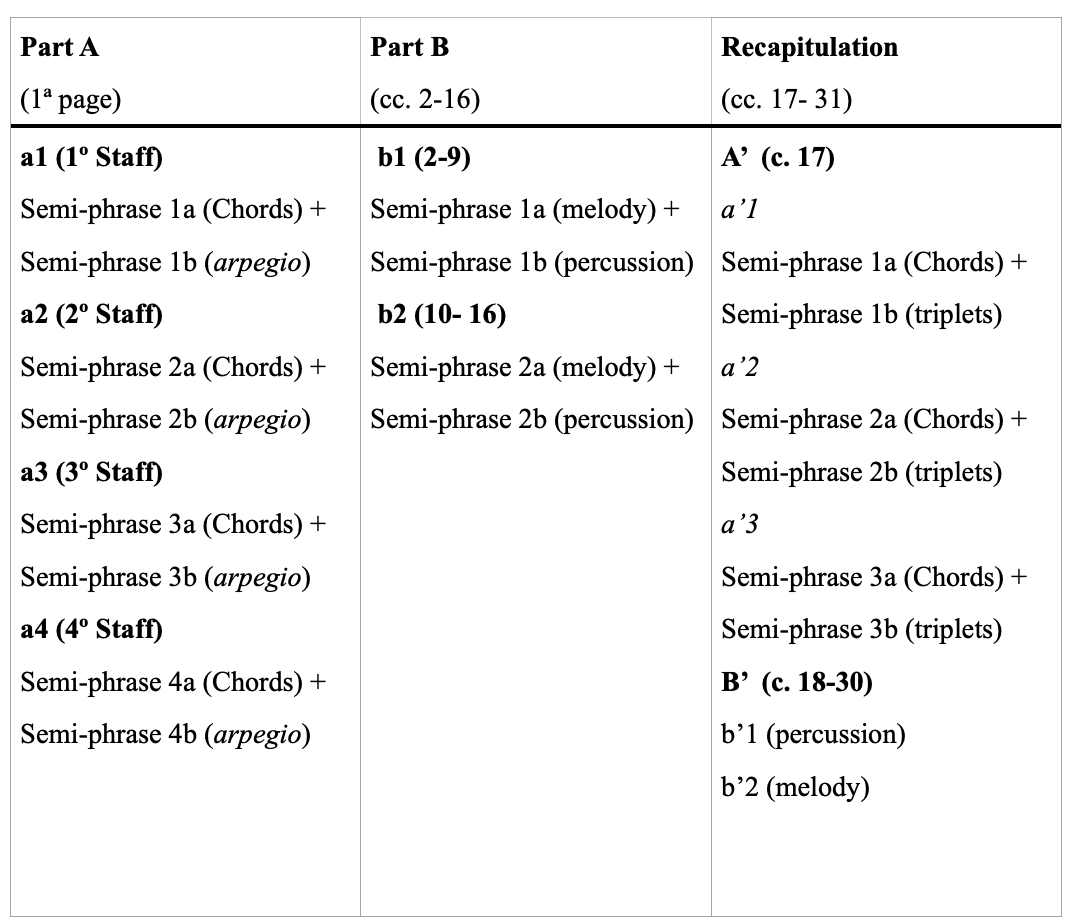
Structure Scheme 1. “Esordio”
The A Part corresponds to the first page of the cited edition. This first part contains four phrases: a1, a2, a3, a4, (four staves) and has no time-signature. Each phrase, in turn, is divided into two semi-phrases that present a contrasting texture: the first is made up of four chords and the second is made up of an ascending melodic gesture that ends in a fermata. After the fourth sentence, a coda appears that marks the end of this first A Part and begins B part.
This first movement begins with the open strings of the guitar (E-A-D-G-B-E). The resulting chord and the note (pitch) E will act as the central harmony, as a representation of the tonic and as the main germ of development, not only of this first movement, but of the entire Sonata. Throughout this work a minor/major second interval conflict will develop, interacting between the notes F and F# and their relationship with E. One of the ways in which this interval set will be presented will be in the pitch set class E-F-F# (012)[21] and it will become the main element of tension and relaxation. This interval conflict will be established in the first two phrases of this movement through the expansion of the interval of the soprano line.
The first semi-phrase (Figure 1) begins with a melodic movement from E to F (between the first and second chord). This change of the two highest notes, C and F, produces a sonority of perfect fourths, emphasized by the arpeggio of the second semi-phrase entirely created from this interval. The resulting new chord corresponds to the pitch set-class 6-32 [22] (024579). The insistence on the repetition of the number “4” can be observed at various levels of concretion: the guitar chord [23], which is mainly made up of perfect fourths, the Sonata, which consists of four movements, the movements, which contain binary divisions, and these, in turn, contain groupings of four phrases.[24] The third chord, compared to the guitar chord, only changes one pitch class (from B to C#). On the fourth chord of the first semi-phrase, it returns to the original guitar chord. The same happens in the next three phrases. Comparing these four successive chords, it can be seen again that the low subset (E-A-D-G) is maintained. This resulting subset will also be maintained in the next three phrases, although it will be transposed.The ascending melodic movement of the soprano line of the first three chords, E-F-A-E, concludes with a Bb at the end of the phrase.

Figure 1 Staff 1.
In the second phrase (Figure 2), as in the first, the low subset is maintained. The top two notes of the second and third chords are transposed to a T1 and T2 [25] level respectively. Therefore, the resulting soprano line, E-F#-B-E, is an intervallic expansion of the previous one. The second semi-phrase begins with an arpeggiated tetrachord (0167), E-Bb-F-B. It derives from the intervallic of the second chord, as in the first phrase. This tetrachord is made up of an augmented fourth, a perfect fifth and another augmented fourth. Between the lowest note of the chord and the top note there is a distance of major seven. The consequence of this configuration of intervals in the harmonic progression derives in a whole tone scale in the upper voice and in a chromatic line in the lower voice within a distance of third interval. The new augmented fourth interval (tritone) will serve as the motivic material later on. Next we find a chord, 3-4 (015), to which it can be assigned a dominant function in relation to the following chord, 3-11 (037), which corresponds to the treble subset of the guitar chord (G-B-E). These two chords will be transposed in a fixed position at T2 level along the neck of the guitar, thus preserving their harmonic function.

Figure 2 Staff 2
The third phrase (Figure 3) begins like the previous ones; with the guitar chord transposed an ascending fifth (T7). The second chord, set class 6-Z19 (013478), maintains the low subset (B-E-A) and enlarges the high subset intervalic (Eb-Ab-C). The third chord, set class 6-Z17 (012478)[26], is an intervallic expansion of the second. It can be related to the tetrachord with which the second semi-phrase of the previous phrase begins, since the upper subset (Bb-E-A-Eb) is created by two augmented fourths separated by a perfect fourth. In addition, the low subset is transposed an extra semitone (T8 with respect to the guitar chord). The fourth chord will be a return to the guitar chord in its original state (T0). Unlike phrases 1 and 2, the arpeggio that follows in the second semi-phrase is derived from the intervallic of the third chord and not the second. This arpeggio begins with two major sevenths separated by an interval of a perfect fourth (tetrachord 0156). Then, as in the second semi-phrase of the previous phrase, this tetrachord will be transposed in a fixed position up the neck of the guitar at a T3 level each time with respect to the previous one, culminating in a chord transposed to the T11 level. Each tetrachord will be separated by two pedal notes, E and A, which form an interval, again, of perfect fourth.

Figure 3 Staff 3
The fourth and last phrase of A part (Figure 4) begins with a transposition at T9 level of the second chord of phrase 3. The third chord is a transposition also at T1 level of the third chord of the previous phrase. The fourth chord returns to the guitar chord, which had not yet appeared in this phrase. The first three chords of this semi-phrase maintain the low subset of the guitar chord but transposed to a T4, T8 and T9 level respectively. As in phrases 1 and 2, the soprano line in the chords of this phrase (A-Db-E) will be an intervallic expansion of the previous one (B-D-Eb). The arpeggio that follows, unlike those of the first three phrases, is descending: with the soprano line ending on the note B and, acting as dominant, it sets the movement back towards E. The bass line descends chromatically (from a B to an F#), which, unlike the previous phrases, is no longer a static bass. The consequent result of this is a progression of opposite movements. As in the second semi-phrase of the second phrase, the first chord of the arpeggio, 3-10 (036), has a dominant function over the following chord, 3-5 (016), achieving resolution through the soprano notes.
After these four similarly structured phrases, there is a short Coda which brings A Part to an end and B Part to begin. The Coda is initially made up of three intervals of descending major sixths separated by major thirds. This will be repeated by transposing a descending perfect fifth. The next two intervals will be another major sixth and a perfect fifth, following the line of the descending gesture. It will end with two chords: the first is formed by a major fourth and a major third, and the second, which concludes this first section, is formed by five notes at a distance of fifths (E-B-E-B-B), which it could actually be understood as reduction of the guitar chord. The articulation marked in the score of this cadence of chromatic contrary movements results in a progressive reduction of the groups of notes: from 4 elements to one element, the final chord that fades into silence.

Figure 4 Staff 4.
Throughout this first part, various moments of tension and distension are created. In the second semi-phrases of the second and fourth phrases there is a clear idea that accentuates the tonic-dominant relationship, so it can established certain tonal relationships between chords and sections. Applying to the guitar chord the function of “tonic” the chords and the sections can be encoded with traditional analysis terminology.
The first and second phrase would be an expansion of the guitar chord (I, tonic). Within this first degree functionality in these first two phrases, functions can be attributed to the first four chords that begin them: I-bII-IV-I first phrase and I-II-V-I second phrase. The third and fourth phrases can be set in the region of the dominant (V) and the last chord of the second phrase as a dominant of the dominant (V/V). Finally this tension is resolved by arriving again at the “tonic”: the guitar chord.
B Part begins on the second page, poco più mosso. This section contrasts with the previous one. Ginastera describes this part of the movement as “a song inspired by Quechua music”. Quechua music comes from the Andean regions and its roots are properly indigenous, although it also combines Hispanic elements. This second section can be related to the popular Argentinean rhythm of the vidala (Figure 5), already used before by Ginastera in other of his works, such as the Danzas Argentinas (1937).

Figure 5. mm. 2-5.
In the case of the Sonata, Ginastera replaces the parallel thirds that characterize the vidala with a sonority that mixes fourths and thirds intervals. This section will be divided into two parts b1 and b2, and each part into two semi-phrases, differentiating between melody (Figure 5) and percussion (tambora) (Figure 6).
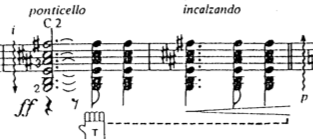
Figure 6. mm. 15-16.
If A part focused on presenting the E-F-F# conflict, here it will emphasise it between the notes F and F# by juxtaposing two whole-tone scales in the soprano line between the first phrase (b1), pitch set class 4-21 (0246), and the second (b2), pitch set class 8-23 (0123578T) (Figure 5 and Figure 7). The register of the first phrase reaches a B (starting from F) and the second reaches an F# (starting from F). This second phrase is a reharmonization of the previous one. The bass line is modified from Ab-dC-Bb to A-C-Bb.

Figure 7. mm. 10-11.
Measure 17 marks the re-exposition, divided into two parts - Tempo I and Tempo II. In this section there is a reduction and amalgamation of theme A and theme B and ends with a coda with clear motivic elements of the A part, a kind of echo of the energetic chords of the beginning.
A’ Part begins at bar 17 (Figure 8). Like part A, it has no meter, although it is now structured in three phrases. The first two alternate three sonorous six-note chords followed by a symmetrical melodic extension of intervals of two groups of quarter triplets. The first chord is the guitar chord transposed to a T2 level. The second chord maintains the low subset of the guitar chord transposed to a T1 level. The third chord introduces the treble subset of the guitar chord in its original form. The melodic line created by these three chords (F#-G-G-E) already shows the intention of resolving the F-F#-E conflict left unclear by the B part. It can be seen this melodic sequence expressed on a wider level by listening to the F# in the chord of the first phrase, the G in the second chord of the second phrase and the E in the last chord of the last phrase. These three chords are harmonized by transposing the guitar chord at the T2, T3 and T0 level respectively. The first melodic extension is formed from descending parallel sevenths separated by minor sixths intervals. The conflict between the F-F#-E can be found between the first interval of these triplets (Gb and F) and the last one (D#-E). The chords with which the second phrase begins are the guitar chord transposed to a T3 and T6 level respectively. The third chord contains the low subset (E-A-D-G) of the guitar chord in its original state and changes the top two notes to maintain the perfect fourth intervals (this chord is already found in the third chord of the first phrase of the movement). The second melodic triplet extension is conformed by 2 groups at tritone distance constituted by parallel minor thirds separated by major sevenths. These triplets complete the total of the 12 tones and the C and F# of the lower voice at the beginning of each triplet are the chromatic generators that form a symmetrical axis of the resulting chromatic scale. The third phrase, in turn, is made up of four six-note chords. The last chord is the guitar chord in its original state and is a resolution of the tension created earlier from the B part.
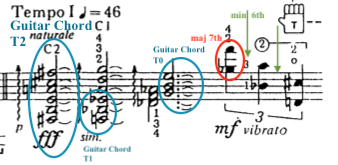
Figure 8. m.17
Part B’ takes up the vidala rhythm and is subdivided into two phrases. The first is developed from the percussive elements that had been presented previously with the sonority of guitar chord and dry hits on the top of the guitar (Figure 9).

Figure 9. mm. 18-23.
The second part takes up the sonority of parallel chords and the whole-tone scale. (Figure 10.)

Figure 10. mm. 24-28.
It retains the new element of the dry-strokes that had been introduced in the previous phrase. Finally, the last bar, the Coda, synthesises the conflict between the F and F# in relation to the E, ending with the guitar chord in harmonic, giving a dreamy feeling. (Figure 11).

Figure 11. m.31.
5.2 "Scherzo"
“The second movement Scherzo, which has to be played “il più presto possible” is an interplay of shadow and light of nocturnal and magical ambiance, of dynamic contrast. Distant dances of surrealistic impressions, such as I had used in earlier career works. Right through to the end the theme of the laud of Sixtus Beckmesser appears as a phantasmagoria.” (Ginastera 1984, I)
This second movement, “Scherzo”, is in stark contrast to the first. It stands out for its melodies, which move through conjunct or chromatic degrees, its varied sound effects, such as Bartók pizzicato, rasgueado with tambora, glissando, étouffée tremolo and hits on the body of the guitar or the use of randomness in some passages. As a result, it generates an “interplay of light and shadow” also reflected in changes of dynamics, timbre and texture or in the exploitation of the register of the guitar, constantly changing from high to low. The linear texture and fast rhythm that characterizes it differs from the low texture and slow tempo of the “Esordio”.
This movement is characterized by a ternary metric and a mainly energetic rhythm. Different rhythms taken from folklore such as the malambo [27] or the gato can be identified. The malambo appears by mixing the rasgueados and the tambora, in such a way that its own rhythmic accents are emphasized (this will be explored, as it will be shown later, in the fourth movement, “Finale”). It is also found in a more complete way by using the characteristic hemiolia. The gato rhythm appears in a distorted form, not only because it is in 7/8 meter, but also because one of the accents is changed at the end with a Bartók pizzicato sound effect. It will be explained in more detail in the fourth movement (« Finale").
At the end of the movement, Ginastera quotes the lute theme of Sixtus Beckmesser, a character in R. Wagner’s opera Die Meistersinger von Nürnberg (1868). The quotation will be discussed in the following analysis.
Structurally , the movement it has been divided into four parts: A, B, C and Coda. The pauses in the rhythm defined by the hemiolias, the calderons, the unbard sections and the dynamic climaxes articulate the beginning and the end of each part. In turn, these will be divided into phrases and differentiated by their motive and textural material. Each section contains similar motives that are reorganised and developed as the movement progresses. (Structure Scheme 2)

Structure Scheme 2. “Scherzo”
Part A begins with two chords of the same intervallic, pitch set class 3-1 (012), D# E F and G A G#. The chord is configured by a minor second and a major second interval, having as a result a dissonant sonority. This beginning presents the intervallic conflict between the notes F and G# that will be developed later. (Figure 12).

Figure 12. mm. 1-4.
In bars 11-14 a motive is presented (Figure 13). Its structure shows the recurring conflict of the F-E interval. The second half of this motive (E D C#) is an inversion of the first half (F G Ab), so they have the same intervallic; pitch set class 3-2 (013).

Figure 13. mm. 11-12.
From the above-mentioned passage the E C# minor third intervallic cell is used and developed in the following bars (cc. 20-28), alternating between the symmetrical motive, pitch set class 3-11 (037) (C# E A C A E), which will be expanded intervallicly, always maintaining the C# pedal, and the E octaves. (Figure 14).

Figure 14. mm. 20-23.
The next phrase is a tetrachord passage of rasgueados made up of two parallel perfect fourths. It maintains the B and E notes of the guitar strings as a pedal. The remaining pitch interval is transposed in the neck of the guitar, preserving the characteristic interval. In the upper line of this passage, Ginastera polarizes the ear to the note D, playing in the upper line constantly with intervals such as F D# and F D. (Figure 15).

Figure 15. mm. 31-32.
At the end of this phrase, he introduces a new percussive element mixed with the rasgueado, maintaining this intervallic interplay that shows the rhythmic accents of the malambo mentioned above. (Figure 16).

Figure 16. mm. 35-36.
Afterwards, in some kind of cadenza prior to part B (cc. 43-49) (Figure 17), in addition to emphasizing the interval of a minor third that Ginastera has been using since the beginning of the movement, he develops the interplay of this D note. Here is kept as a pedal note and juxtaposes a melodic line of a whole-tone scale (articulated every two bars), as it had been done in the first movement, and another line that moves through an intervallic pattern of ascending minor second and descending minor third (until bar 46), ending in a reiteration of the D note by octaves.
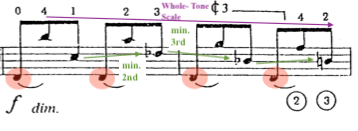
Figure 17. mm. 43-44.
The B part begins with a perfect fourths chord, pitch set class 3-7 (025) (D#-G#-C#), which is transposed to a T11 level by a descending glissando, reaching the low sub-set of the guitar chord. Then, a twelve tone row is developed and transposed to its P3 form (see Matrix 1). This series has several properties that pick up the intervallic conflicts that were already presented: it is made up of three diminished seventh chords separated by a perfect fourth; the two forms of the series follow each other and the notes are in groups of threes. (Figure 18).

Figure 18. mm. 52-55.
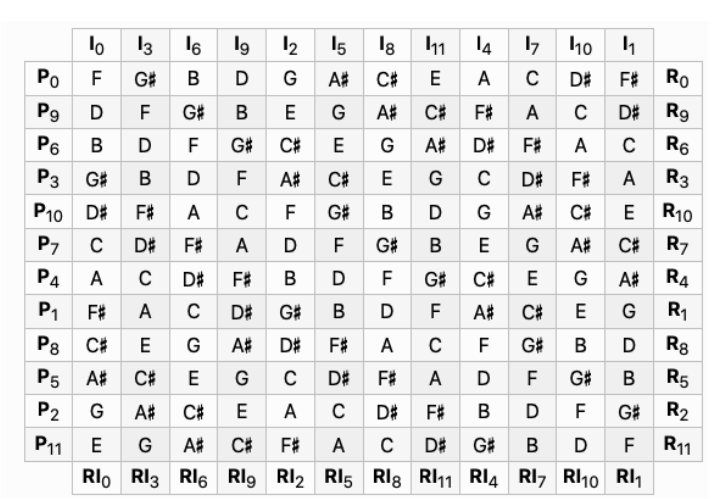
Matrix 1
The conflict between E-F-F# will be developed later (cc.60-79) by interplays of intervallic tension, generated by chromaticisms that are resolved in an E. In bar 72 it can be found a tonal reference, a dominant-tonic relationship, due to the polarization caused by the reiteration of the B, which resolves again in E in bar 79. In addition, there will be a kind cadenza (B-E, dominant-tonic), and through a six-second aleatoric passage, where some elements are left to chance to the determination in this case of the guitarist. This passage leads to the end of the section in an apotheosic Bartók pizzicato on the sixth string. (Figure 19).

Figure 19. mm. 88-91
Part C (cc.92- 141) uses and develops mainly material from Part A and, to a lesser extent, Part B. It has been divided into six sections depending on the motivc material that it develops: c1, c2, c3, c4, c5 and c6. It begins with two series of twelve-tone. The second is the I0 form of the first, i.e. the inversion. It is structured around the note G and its reach to F# in the following phrase. (Figure 20) (See Matrix 2).

Figure 20. . mm. 92-95.
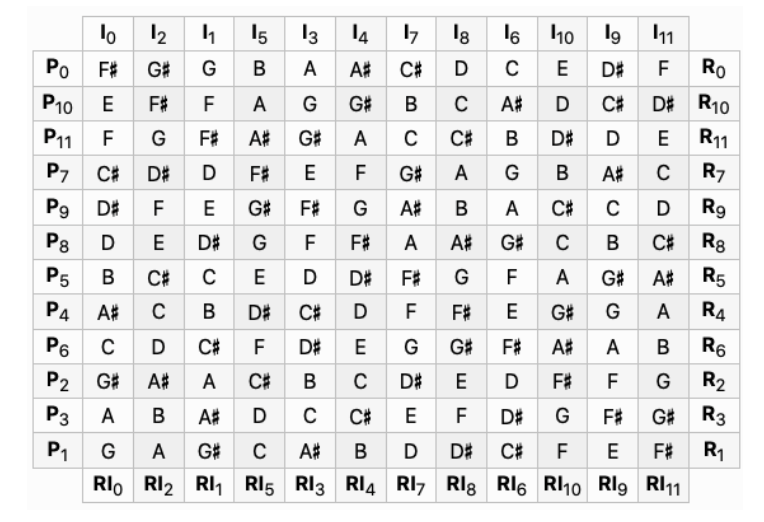
Matrix 2
The following passage, c2 (cc. 90-104), is developed in a very similar way to the one of bars 29-36. This time, the open strings will be D and G, and the transposition movement will take place on the fifth and sixth strings, creating an intervallic conflict between the notes F# and F. (Figure 21).

Figure 21. mm. 96-98.
In c3 (cc.104-114) there is an offset between the time signature and the natural articulation caused by the intervallic of major sevenths separated by a minor third distance. The major seventh intervallic causes two melodic lines; one in the soprano and other in the bass dividing the passage by register and producing diminished seventh arpeggios. This passage is a juxtaposition of two twelve-tone series, in particular the one presented above in bars 52 and 53. The first serie of the upper line is found in its original form, while the serie of the lower line is found in its P1 form. (See Matrix 1). This whole passage is a movement from the note F towards the note G. (Figure 22).

Figure 22. mm. 104-108.
In c4 (cc. 115-126), in bars 121-124 it is found again the twelve-tone serie used in bars 92 and 93 in a P4 form. (Figure 23).

Figure 23. mm. 21-124.
In c5 (cc.127-134), it is found motivic material from Part A: the rasgueado mixed with tambora derived from the malambo rhythm. (Figure 24).

Figure 24. mm. 131-134.
This is followed by another passage similar to the one in bar 104, using another twelve tone serie (bars 3 and 4, Figure 24). At the end of this section, c6, it will be found a cadence similar to the one of part B, using ascending and descending glissandos, which transports from an initial E to an F# and F, which will resolve into the guitar chord of Sixtus Beckmesser’s lute theme. (Figure 25)

Figure 25. mm. 135-141.
The Coda (cc. 145-158) has been divided into four sections. The first and third sections correspond to a quotation from the lute theme of Sixtus Beckmesser [28], a character in R. Wagner’s opera Die Meistersinger von Nürnberg. It is developed around the note E and the guitar chord in arpeggiated overtones. This quotation is entirely literally adapted to the sonority of quarter notes that characterizes the colour of the guitar chord and the Sonata. (Figure 26).
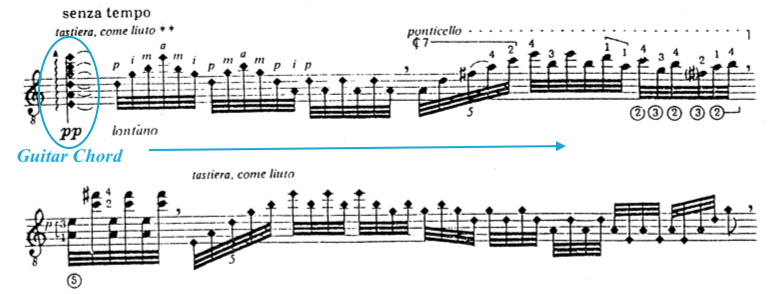
Figure 26. m. 142. Sixtus Beckmesser
In the third, the quotation will be played transposed from the first to a T4 level (a major third). (Figure 27)
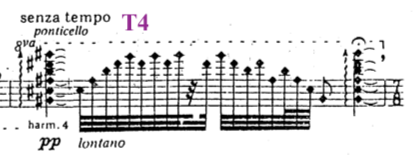
Figure 27. m. 151.
The last phrase and final coda is a cadenza with a Phrygian sonority and with a tonal relation of plagal cadence (IV-I) that resolves in a brilliant Bartók pizzicato of the note E, whose resonance is gradually lost and blurred. (Figure 28).

Figure 28. mm.152-155.
5.3 "Canto"
“The third movement, Canto, is lyrical and rhapsodic, expressive and breathless like a love poem.” (Ginastera 1984, I)
Audio and Video Example 7, Alberto Ginastera, Sonata op. 47, “Canto”. (Personal Interpretation).
This third movement has many characteristics in common with the first one. It has no time-signature and is structured in a very similar way: it consists of two contrasting main themes and a re-exposition in which it syncretizes these two themes. (Structure Scheme 3).
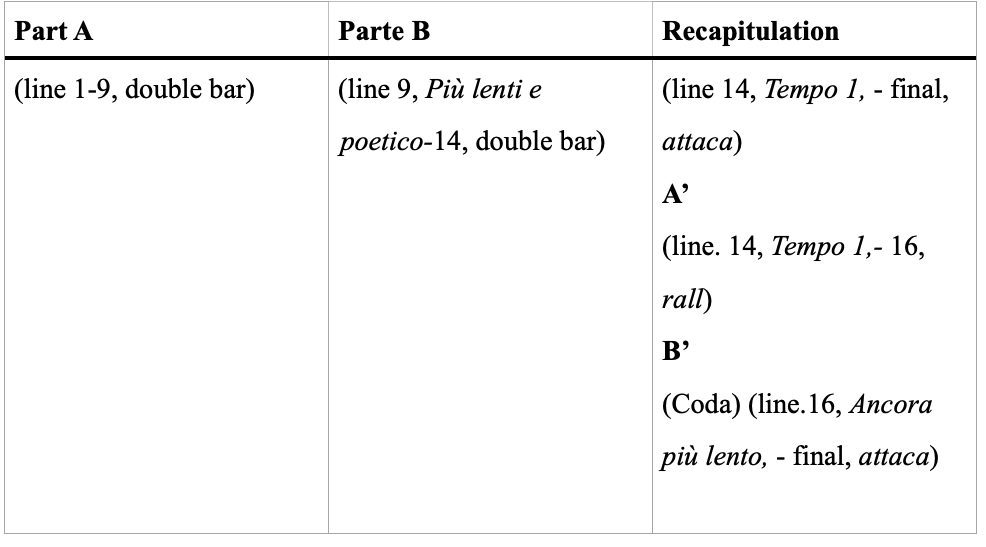
Structure Scheme 3. “Canto”
In this movement Ginastera uses the twelve-tone technique to develop the intervallic relationships presented above. In this analysis it will mainly be focused on explaining how he uses this compositional technique in relation to the elements of the work such as the guitar chord, the tonal references (B-E) or the E-F-F# conflict.
A Part begins by using a resource typical of the music of South American Indian tribes, which consists of the reiteration of a single note. In this part it appears as an ornament (trill) around the note F#, which will be the main to develop this section. It will be harmonically supported by the E and always embellished by its neighbors G or F. The first chord, E-A#-D#-G-C#-F#, pitch set class 6-27 (013469), will be the most recurrent material throughout the movement, mainly because of the intervals that make it up —major sevenths, perfect fourths and tritones— and its symmetrical intervallic structure (Figure 29).
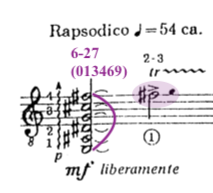
Figure 29. Staff 1.
The ornamentation will be developed in the form of a trill, as mentioned above, or in the form of twelve-tone row. The twelve-tone row it employs can first be seen in its original form at the end of the first staff. One of the main properties of the organization of the series, besides the fact that it derives from the first chord, is that the intervals of the second hexachord are the retrogradation of the first hexachord transposed one tritone. (Figure 30).
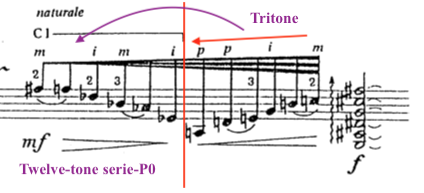
Figure 30. Staff 2.
In the third staff, it will be shown in its P7 form (Figure 31 and Matrix 3), i.e. the original form transposed to a T7 level (perfect fifth). At the end of the page, in the last grouping, there is a break of the row, presenting a sequence of ten notes starting on F. This sequence will take up to G at the end of the sixth staff and will be resolved on the F# that characterizes this section.

Matrix 3
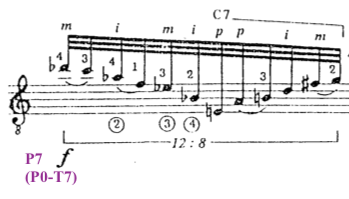
Figure 31. Staff 3.
The end of that section shows an omen of the conflict between B and E, which will be developed mainly in B Part. The last three chords and the preceding passage use the B reiteratively, concluding, for the first time in the whole section, in a resolving way on the guitar chord.
B Part (p. 9-14, double bar) uses material from the second theme of the first movement. The descending melodic line, Pitch set class 4-21 (0246) (B-A-G-F-E), contains the same whole-tone tetrachord that was used in the B section of the first movement, showing the “tonic-dominant” relationship (B-E). In addition, in the links of these chords it can be observed another twelve-tone row. The intermediate notes descend chromatically (E-Eb-D-Db) and the bass and soprano descend by parallel sevenths. This twelve-tone row is directly related to the initial chord. (Figure 32).

Figure 32. Staff 9, Più lento e poetico.
He then develops this descending line using arpegios. At the end of the penultimate staff and on the last staff of this second page he inverts the order of this whole-tone scale (F-G-A-B). (Figure 33).

Figure 33. Staff 10 -11
From the indication of Tempo II, it can be observed a kind of Coda that leads to the Reexposition, Tempo I. Once again it is found this tetrachord with the order inverted (F-G-A-B). This inversion can be understood as a tonal relationship of secondary dominant (F-B, V/V-V), which resolves in an E (I). This E will lead directly to the F# that characterizes the initial chord and marks the Reexposition. (Figure 34).

Figure 34. Staff 13, Tempo II.
The Reexposition is marked by Tempo I. It begins by returning to A Part, in a reduced form, varying the material developed around the F#. (Figure 35).

Figure 35. Staff 14-15.
It ends with a Coda marked by the signalling of Ancora più lento based on a synthesis of B Part (Figure 36). This final coda begins with the twelve-tone row of B Part transposed to a T7 level. The last chord, pitch set class 5-29 (01368), has a dominant function over the guitar chord, and resolves into it at the beginning of the fourth movement.

Figure 36. Staff 17, Ancora più lento
5.4 "Finale"
“It is connected with the last movement, Finale, a quick spirited rondeau which recalls the strong, bold rhythm of the music of the pampas. Combinations of rasgueados and tamboras percussion effects, varied by other elements of metallic color of the resounding of strings, give a special tonality to this rapid, violent movement which thereby gains the overall aspect of tocatta.” (Ginastera 1984, I)
According to Marcinizyn’s division into sections in Movements for Orchestra (original composition) and Pitch structure and harmonic motion in Ginastera’s Sonata for Guitar, the movement has been differentiated into six parts: Introduction, A, B, C, D and a Final Coda, separated from each other by the climax of each part. These climaxes have common elements such as dry strokes or chords with a dynamic density of fff or sfz. (Figure 37 and Structure Scheme 4).
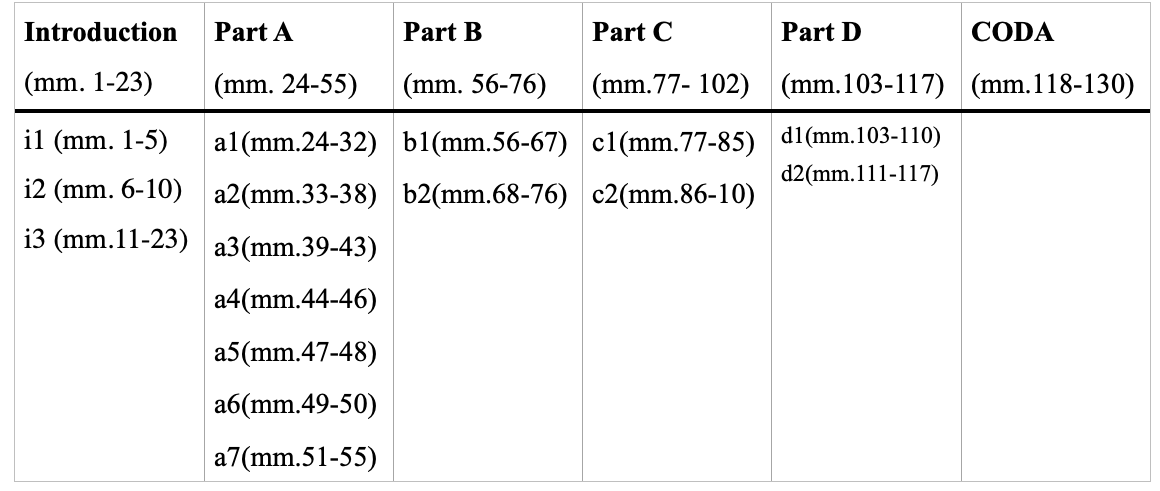
Structure Scheme 4. “Finale”

Figure 37. m. 23
This movement begins with strummed chords alternating with percussive tambora effects creating a typical effect reminiscent of the playing style of Argentine folk music. It can be distinguished various rhythms derived from Argentine folklore such as the malambo, the chacarera, the milonga and more hidden the gato.
In the choreography of the malambo, a fast dance that combines the time signature of 6/8 and 3/4 by creating hemiolias at the end of phrases (Figure 38), each dancer imitates some steps of his predecessor and adds a new one. This is the model adopted by Ginastera for the rondo of fast movements. [29]

Figure 38. m. 1-5.
To a lesser extent it can be appreciated the chacarera rhythm in bars 90 to 93 (Figure 39). The fingering indicated by the thumb of the right hand arpeggiates the chords and falls on the third and fifth eighth notes of the bar, which causes a natural accent on these beats, typical of this rhythm.
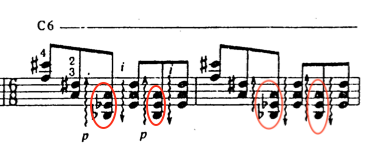
Figure 39. mm. 90-91.
The milonga rhythm (3+3+2) appears in 8/8 time signatures. It is characterized by its asymmetry. (Figure 40).

Figure 40. mm. 68-70.
The gato is modified as was shown in the « Scherzo » (Figure 41).
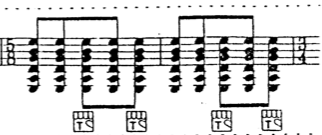
Figure 41. mm. 3-4.
The opening chords (first page, cc. 1-23) correspond to the Introduction. Throughout this movement there are constant motivic allusions to this first section through the use of the characteristic rasgueo, the malambo rhythm (Figure 38). This Introduction will be divided into three phrases separated by the hemiolia produced by the change to 3/4. Each phrase begins with the guitar chord. This section is structured around the harmonic movement from E to B (guitar chord transposed to a T7 level) while maintaining a tonic pedal. In the first phrase the soprano line moves between the notes E-F and Ab, pitch set class 3-3 (014). In the second phrase there is an intervallic extension of the previous melodic motive: E-F#-Gb-Bb-D#, pitch set class 5-10 (01346). The third phrase maintains the soprano line of the second phrase (E-F#-Gb-Bb) but harmonized differently and expanded intervallicly (D-E-F#-Bb). This phrase is four bars longer than the previous ones. From bar 19 onwards, there is a clear emphasis of the movement towards the B (dominant of the E, established as the tonic in the guitar chord). The chord presented in this bar with the E in the soprano has a harmonization that is totally different from the intervallic of the guitar chord. The upper tetrachord it creates, B-F-Bb-E, pitch set class 4-9 (0167), offers a dominant function with respect to the following chord. The chord in bars 20-22, with F# in the soprano line, also has a dominant function with respect to the next chord, the guitar chord transposed to a T7 level, with the B in the soprano.
From the beginning of the movement, the above-mentioned conflict between E-F-F# is shown in the beginning of each phrase. The chords in this section contain in their intervallic construction major sevenths, perfect fourths and tritones.
The second section, Part A, will be divided into seven phrases according to the motivic material that is used. The first phrase (cc. 24-32) consists is mainly made up of parallel major triads. These chords fluctuate mostly between the F and Ab chords, always with the B-string added, providing a dominant function to the whole passage, pitch class set 4-Z29(0137) and 4-12 (0236) respectively. This first phrase ends on Eb, which serves as a passing note to the F, which initiates the next phrase (cc.33-38). This phrase creates an ascending melodic line: F-G-A-B-D-E, pitch class set 6-33 (023579), ending in a kind of “perfect cadence” created by the dominant chord with the B in the soprano, pitch class set 6-33 (023579), and its resolution in the guitar chord. Again, the rhythmic and technical elements (rasgueados) used in the introduction are used again. The next phrase, a3, (cc. 39-43) and phrase a5 (cc. 47-45) are very similar, and it is found again the fluctuation between F and Ab in the soprano voice. These two sections are divided by a chord passage that again presents the conflict between F-F# and E, with two low notes of the guitar chord with pedal function and a high tetrachord, pitch set class 4-6 (0127). The resulting intervallic of sevenths and seconds creates a dissonance that increases the tension of the passage. The sixth phrase of this section is a “perfect cadence” of chords, similar to the one found earlier in bars 37 and 38.
The next and last phrase of this part is a chromatic progression of the tetrachord pitch set class 4-9 (0167), created out of fourths (diminished, augmented and perfect), played in a steady position on the guitar neck.
In part B (cc. 55-76), it is found motivic material from the Introduction, between bars 59 and 62, as well as the milonga rhythm between bars 68 and 70. (Figure 40).
Part C (cc. 77-102) is divided into two parts; the first from bars 77 to 85 and the second from bars 86 to 102. It begins, as on previous occasions, resorting to the milonga rhythm. The soprano line again shows the “dominant-tonic” relationship between the B and E (Figure 42).

Figure 42. mm. 77-79.
The upper tetrachord of bars 81-84, pitch set class 4-9 (0167) has a dominant function and resolves into the guitar chord. At the beginning of the second section of this part C combines mainly two intervals: the tritone in the bass line (A-Eb) and the major sixth (A-F#) between the bass and the soprano. Then, the same motive will be shown transposed, and the bass line will be descending, so the tritone interval will become a descending minor third (F-D).
Between bars 90-98 there is a soprano line of ascending fourths (C#-F#-B), that creates a relationship of dominants to each other and finally leads to a cadence in three B chords in overtones (guitar chord transposed to T7 level). The section ends in a similar way to part A, with a chromatic progression of parallel chords.
Part D (103-117) begins using motivic and rhythmic material from Part A (cc. 24-25)(Figure 43). In it, it had been pointed out, an intervallic relationship present in the bass line between the notes F and Ab from on parallel major triads. These parallel triads and this intervallic relationship are still hidden in a tetrachord. (Figure 43). The melodic line of the soprano will now be doubled in the bass (C-Eb). The last three bars of this section repeats in descending direction a whole-tone tetrachord in the soprano line (F#-E-E-D), pitch set class 4-21 (0246), with a pedal from the bass subset of the guitar chord, leading into a dominant pedal of the final Coda.
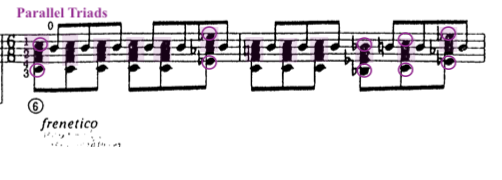
Figure 43. mm. 103-104.
The Coda (118-130) is mainly made up of the motivic and rhythmic material of the Introduction. In addition, these chords can be also related to those used in the final sequence of the third movement (Figure 44). All the chords in this section creates a harmonic progression, always keeping the note B in the soprano. In this way, together with the note of the score molto accentuato, delirante, the tension will be intensified to the maximum until it ends, for the first and last time, in a complete E major chord and finally in the guitar chord that has been playing the function of tonal centre throughout the Sonata.
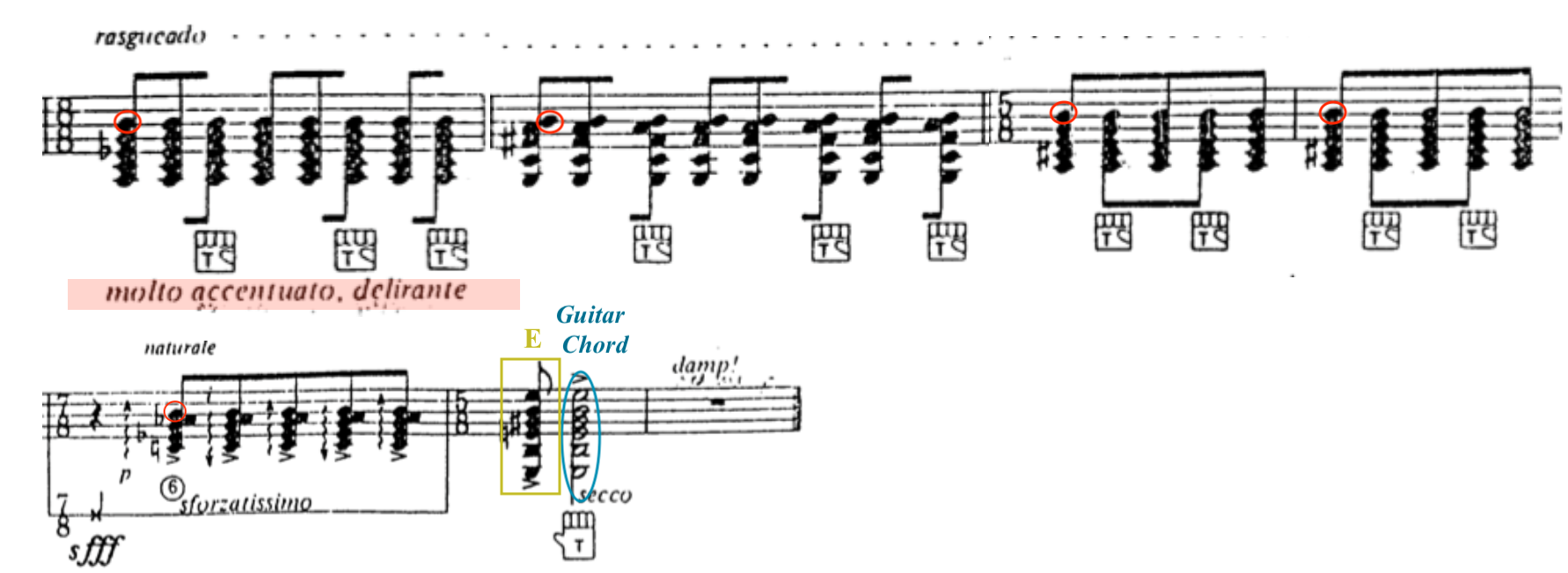
Figure 44. mm. 118-130.
6. Comparison of Compositional sources: String Quartet no. 1, op. 20 (1948)
This Sonata for Guitar composed in 1976 shares a variety of features with other earlier works such as the String Quartet no. 1 (1948).
As discussed above, Ginastera made obvious and patent use of Argentine folklore, especially in his early works of his first period. It is with the String Quartet no. 1, op. 20, the work with which it can be considered a period change, an evolution from what has been described as objective nationalism to subjective nationalism. The use of folk elements will be presented in a more symbolic and subtle way, reformulated in a compositional language inspired by the avant-garde, serialism and twelve-tone. The result of this is a more personal compositional identity that does not leave aside the predilection for traditional airs and its folkloric roots.
Ginastera himself enumerated three constant characteristics in all his works: an exaltation of lyricism, the use of strong rhythms, taken from masculine dances, and finally a certain expressionist climate, seeking to evoke an almost magical ambiance[30]. These three constants expressed by the Argentinian composer can be found in the pieces mentioned above in addition to many other common elements that will be discussed below. These two compositions are structured in four movements and have almost an identical scheme. The first movement is an energetic introduction. The second movement is a fast scherzo in 6/8 meter, with changes in dynamics, colour and timbre and a strong contrast between the beginning and the ending, creating an atmosphere of chiaroscuro and “magical ambiance”. In addition, the closing measures of the second movement of the Sonata for Guitar are nearly identical to those of the second movement of the String Quartet no. 1.
Essentially, the second and fourth movements share the same compositional characteristics and procedures as those analysed in this research, so they will not be analyse in detail to not become too redudant. Neither is the main aim of this study to provide a detailed analysis of the complete work.
Below, some common characteristics in the development of the two works will be presented. It is important to note two compositional aspects that have increased their importance and presence in post-tonal composers : the timbre, texture and dynamics. The timbre refers to tone color, and its range will be expanded and will be exploited to the fullest extent of the instrument’s capabilities. The texture concerns the relationships between the rhythms and contours, but it also concerned with aspects such as spacing and dynamics [31]. This exploration of the timbre and texture is directly related with the influence of folk music.
Following the formal structure of the traditional models, Ginastera uses the sonata characteristics to constitute the schema of the String Quartet, both within the movements and in an overall view of the work, showing again his predilection for normative large-scale forms, which were commonly used by composers in the eighteenth and nineteenth centuries [32] . Inside the movements of the piece, as it was presented in the Sonata for Guitar, two themes will be identify and contrasted with another central section, a development created from the material of these themes. Thus, traditional formal associations are evoked but without the tonal characteristics involved. Ginastera emphasizes the contrasts of the important thematic materials by changing rhythms, dynamics, texture, tempo, range or articulation.
The String Quartet no. 1, op. 20 has four movements and the tempo indications of them are related to the ones in the Sonata for Guitar, so the atmosphere generated in the performance remains similar:

Comparison Chart
The first movement, Allegro violento ed agitato, has three sections in sonata form (exposition, development and recapitulation). It begins with a six bars and energetic Introduction that present the sound collection of the basic motive of the movement (twelve-tone row). The thematic material of the sections are derivates of the Introduction. The basic motive showed in the begging will also be used in the Coda to finalize the movement. As a result, the structure is unified and balance (Figure 46). This resource is also used to conform the structure in the Sonata for guitar, specially clear in the third and fourth movement: “Canto” and “Finale”.

Figure 46. I. Allegro Violento ed Agitato mm. 1-6 and Coda (Più mosso quasi presto).
This final Cadence ends using the sonority of one of the main compositional resources of Ginastera, the guitar chord. This end brings consonance and a feeling of resolution from the sonority presented before: a dissonant harmony disposed in symmetrical pitches. (Figure 47). Once again, this compositional resource was also seen in the Sonata for guitar, not only in the ending of the first and fourth movements, “Esordio” and “Finale”, but also throughout the whole work, where this guitar chord is the main element and the motivic motor to develop the interval distances.
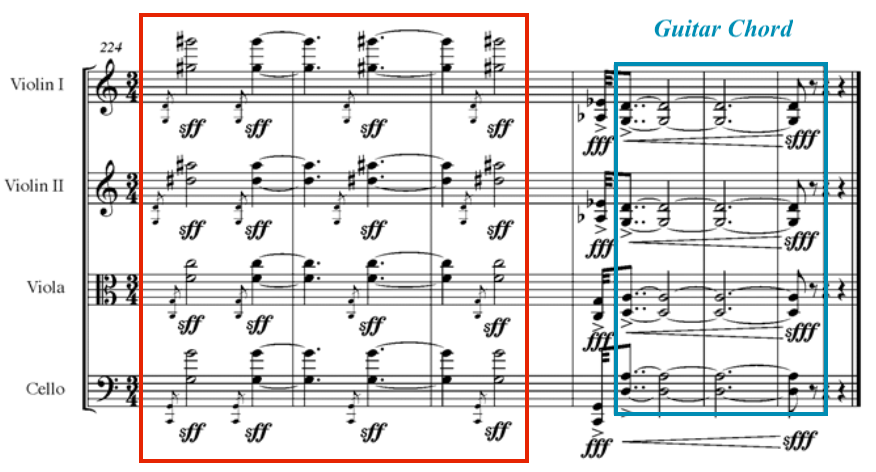
Figure 47. I. Allegro Violento ed Agitato . Final Cadence mm. 224-229.
The third movement has a ternary form, and articulates the division of each section with fermatas: Part A, Part B and recapitulation, as it was shown also in the third movement of the Sonata for Guitar, “Canto”. (Structure Scheme 5 and 3).

Structure Scheme 5. “Calmo e poetico”.
In the same way as was shown in the previous analysis of the third movement of the Sonata, the Part A and the recapitulation will show the main motivic material and the Part B will be contrasting by the use of counterpoint texture. This movement ends with an indication of perdendo, that connects with the energetic fourth movement and emphasize the contrast between them, as it was done between the “Canto” and the “Finale”.
Furthermore, these are not the only similarities between the third movements of these two works. In the String Quartet, Ginastera also uses the compositional resource typical of the music of South American Indian tribes, which consists of the reiteration of a single note. This is presented as an ornament (trills) or in the development of the melodic lines or motives, making use of the major and minor 2nd intervals. Moreover, it is relevant to note that this movement starts with the “guitar chord” and it is maintained as ostinato in the cello, viola and second violin, while this first violin develops the interval conflicts (Figure 48). The recapitulation will finish with the guitar chord in a similar way as it was done in the first movement. (Figure 49).
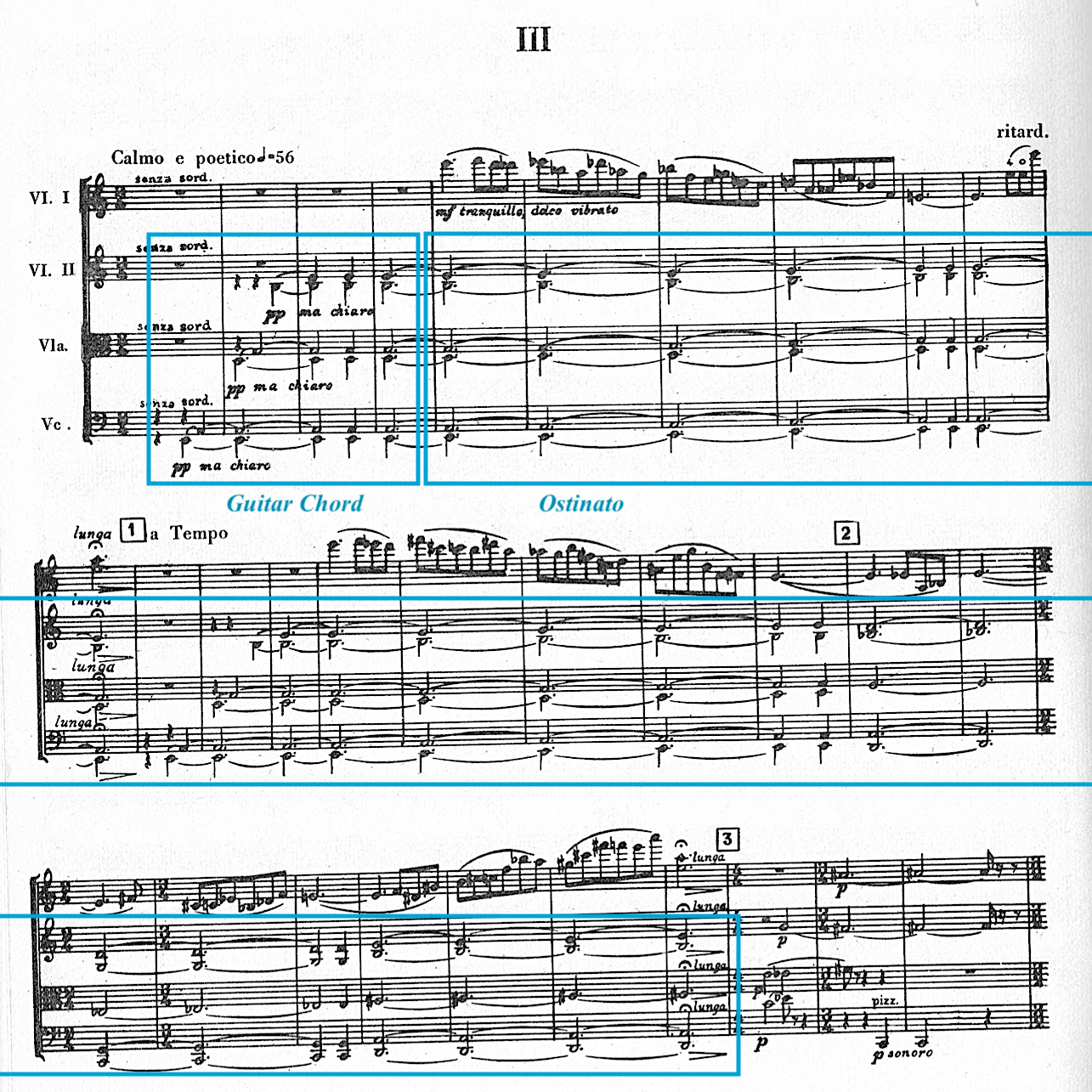
Figure 48. III. “Calmo e poetico” mm. 1-28.
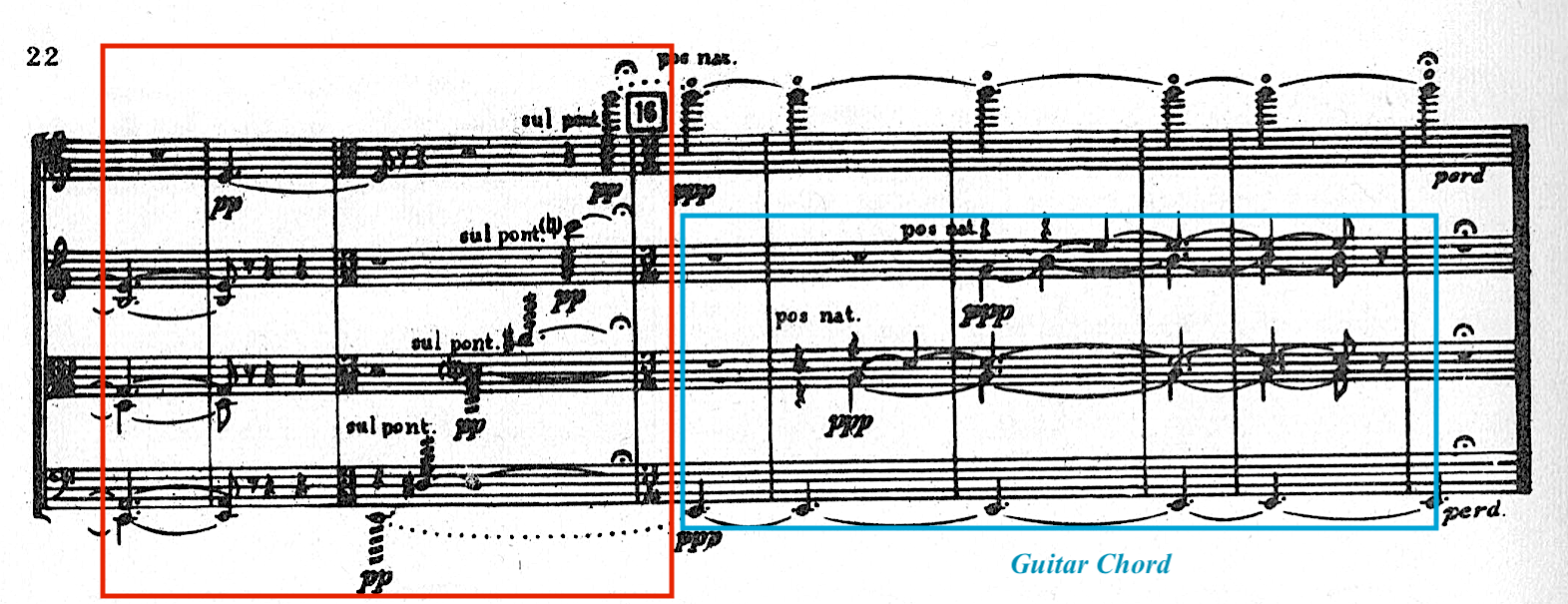
Figure 49. III. “Calmo e poetico” mm. 107-113.
Almost thirty years separate these two works by Ginastera which, as it can be seen, share a good part of the compositional constants of the Argentinian composer, but, at the same time, it can be notice two profound changes that confirm that the Sonata for guitar represents a significant degree of evolution and musical maturity. Firstly, Ginastera discovers the capacity of the guitar as a solo instrument capable of expressing the complexity of his compositional and musical language, a fact which, on the other hand, is a risky and novel experiment within his extensive work. But, at the same time, the specific qualities of the solo instrument itself, with its virtues and limitations, oblige him to condense and stylise the rhythmic and harmonic resources until he reaches that high degree of essentiality which, as can be appreciated, the Sonata represents.
7. Conclusion
Despite being his first and only work for guitar, the Sonata, op. 47 (1976), represents, within Alberto Ginastera’s musical career, more than a starting point, a point of arrival, a clear example of what Theodor W. Adorno called “creative maturity” and a work of synthesis that can only be understood and explained if it is taken into account the variety of compositional and motivic materials, his own and those of others artists, that the composer successfully manages to bring together. It has been tried to show how the warm echoes of traditional folk dances or the prominence of rhythm and percussion merge —rather than contrast— with the precise, calculated and meticulous dodecaphonism and serialism. Also, it has been presented, taking as a reference his previous String Quarter no.1, op. 20 (1948), how in this Sonata is perceived an evolution and development of his own musical language, but, at the same time, a stylisation that sometimes represents an antithesis of itself. In contrast to the orchestral grandeur he had previously displayed in works such as the Cantata for América Mágica, op. 27 (1960) or the audacious cultivation — though still recognisable within the compositional tradition — of large forms, such as his opera Bomarzo, op 34 (1966), Ginastera now leans towards the apparent restraint involved in writing for a single instrument. But the reality is that, once again, he goes beyond the usual limits and manages to create sonorities on the guitar that go beyond those produced only by the plucking of its six strings.
As for its musical language, as it has been highlighted in the analysis, it can be concluded that it can be observed how two main intervalic conflicts develop in the work, that have to do precisely with the harmonic essentiality of the guitar: one between E-F-F# and the other between E-B. Each of them alludes to a different referent; the first leads directly to Argentinian folklore, and the second leads to tonal language. The cohesion and parallel development of both conflicts is a direct reference to the guitar chord, which it has been established as the tonal centre of the work. In Argentinian folklore, variations in the tuning of the guitar are also often found, changing the chord, resulting in the variant E-A-D-G-C#-F#.
Regarding the succession of movements in the Sonata, it can be observed that each one of them maintains its own style and a contrasting character in which different techniques and elements are combined. Ginastera achieves this contrast by mimetizing procedures as rigorous and strict as dodecaphonism and serialism, and at the same time seemingly so far from the traditional concept, with tonal references and folklore, adapting to the limit the intervallic designs that characterize the work.
Since its premiere, the Sonata has attracted increasing interest for its innovative contributions to contemporary music. The result is a tribute to the guitar, to the Argentine folk music and to avant-garde music. Ginastera shows how, by using such apparently diverse materials, he adapts and transforms them to create a composition assembled with mathematical precision, but which does not produce in the listener a sensation of impersonality or coldness; on the contrary, it demands active listening. As performers of this work, it has been wanted to discover, understand and explain —and then be able to communicate and transmit— how beneath a score written with careful detail and precision, full of rigorous annotations and indications for correct performance, hides an invitation to discover its occult essentiality.
As far as the guitar as an instrument is concerned, Ginastera’s great contribution is that in it he explores a great variety of innovative resources that verify its suitability to transmit the contents of contemporary music, while at the same time settles the debt he had to Argentine folklore and the old Creole guitar, on so many occasions, as it has been emphasized, present in his rhetoric and symbolically evoked, but now transfigured into a reality.
8. Bibliography
Aretz, Isabel. 1973. El folklore musical argentina. Buenos Aires: Ed. Ricordi.
Ariel Lezcano, E., P. Bianicci, y E. Rodriguez. 2011. “Ginastera Nacionalista”, Arte Investigación, Año 13, no. 7, Facultad de Bellas Artes de la Universidad Nacional de La Plata, 116-122.
Barnett, Jessica R. 2007. Alberto Ginastera’s String Quartets Nos. 1 and 2: Consistencies in Structure and Process. Degree of Master of Music in Music Theory. The University of Cincinnati.
Basisnki, Mark A. 1994. Alberto Ginastera’s Use of Argentine Folk Elements in the Sonata for Guitar, op. 47. Degree of Doctor of Musical Arts. The University of Arizona.
Forte, Allen. 1973. The Structure of Atonal Music, New Haven and London: Yale University Press.
De Pablo, Luis. 1983. “Ginastera, la voz de un mundo mágico”. El País, 28 de junio, Madrid: 32.
Gaviria, Carlos. 2010. Alberto Ginastera and the Guitar Chord: An Analytical Study. Degree of Master of Music. University of North Texas.
Ginastera, Alberto. 1976. Sonata for Guitar, op. 47. Nueva York: Boosey & Hawkes.
Ginastera, Alberto. 1954. String Quartet no. 1. Buenos Aires: Boosey & Hawkes.
King, Charles. 1992. Alberto Ginastera’s Sonata for Guitar, op. 47: An Analysis. Degree of Doctor of Musical Arts. The University of Arizona.
Kostka, S. and M. Santa. 2018. Materials and Techniques of Post-Tonal Music. New York: Ed. Routledge.
Kuss, Malena. 1998. “Nacionalismo, identificación y Latinoamérica”, Cuadernos de Música Iberoamericana, Vol. 6. Madrid: ICCMU, 133-149.
Kuss, Malena. 2013. “Ginastera (1916-1983): La trayectoria de un método”, Revista Argentina de Musicología, no. 14, Buenos Aires: 16-52.
Madoery, Diego. 2016. “Estudios sobre el folclore musical argentino”, Revista Argentina de Musicología, no. 17, Buenos Aires: 15-38.
Madoery, D and S. Mola. 2014/2015: “Del bombo legüero a la batería. Modificaciones rítmico-texturales en la chacarera”, Revista Argentina de Musicología, no. 15-16, Buenos Aires: 355-374.
Martinizyn, John Michael. 1994. Movements for Orchestra (original composition) and Pitch Structure and Harmonic Motion in Ginastera’s Sonata for Guitar. Degree of Doctor of Philosophy. University of Pittsburgh.
Perle, George. 1990. “Pitch-class Set Analysis: An Evaluation”. The Journal of Musicology, no. 2: 151-172.
Barnett, J. 2007. Alberto Ginastera’s String Quartets Nos. 1 and 2: Consistencies in Structure and Process. Degree of Master of Music. University of Cincinnati.
Nissman, Barbara Nissman. 2016. “Remembering Alberto Ginastera - A Centenary Tribute”. Musical Opinion Quarterly, no. 1507, London: 18, 20.
Plesch, Melanie Eugenia. 1996. “La música en la construcción de la identidad cultural argentina: el topos de la guitarra en la producción del primer nacionalismo”, Revista Argentina de Musicología, no. 1, Buenos Aires: 57-66.
Ruiz Tarazona, Andres. 1977. “El único compromiso del arte es el estético. Entrevista con el compositor argentino Alberto Ginastera”, El País. Madrid.
Schmidt, Timothy. 1994. Alberto Ginastera and the Guitar. Compositional Materials and Revisions in the Sonata for Guitar, op. 47. Degree of Doctor of Musical Arts. Manhattan School of Music.
Schwartz-Kates, Deborah. 2010. Alberto Ginastera: A Research and Information Guide. New York-Londes: Routledge Music Biliografies.
Schwartz-Kates, Deborah. 2016. “Reflexiones sobre el compositor Alberto Ginastera en el centenario de su nacimiento. Logros, retos y consideraciones para el nuevo siglo ginasteriano”, Revista Argentina de Musicología, no. 17, Buenos Aires: 115-131.
Sottile, A. 2016. “La práctica de la cita en Alberto Ginastera”, Revista del Instituto Superior de Música, no. 16, Instituto Superior de Música, Santa Fe, UNL, República Argentina: 131-156.
Suárez Urtubey, Pola. 1972. Ginastera en cinco movimientos. Buenos Aires: Ed. Lerú.
Suárez Urtubey, Pola. 2003. Ginastera: veinte años después. Buenos Aires: Academia Nacional de Bellas Artes.
Vega, Carlos. 1944. Panorama de la música popular argentina. Buenos Aires: Ed. Losada.
-
Ian Bostridge, “Viaje de invierno” de Schubert: Anatomía de una obsesión. Translated by Luis Gago (Barcelona: Acantilado, 2019). ↩︎
-
John Rink, “Análisis y (¿o?) interpretación”, in La interpretación musical (Madrid: Alianza Editorial, 2006), 55-80. ↩︎
-
The scores of the referred works themselves, will be taken as main source and as a start of the research. ↩︎
-
To date, none of the works focused on this Sonata have attempted to combine in the same project the analysis of the reformulation of folklore in an avant-garde language and the combination of traditional methods of analysis with others typical of atonal language. The research and comparison of compositional resources within the broad spectrum of Ginastera’s language and within the String Quartet no.1 has also not been valued. In any case, the focus of this research is not only on the analysis of a score, but rather that this analysis will lead to a vision of Ginastera’s music that can be translated into our performance practice. ↩︎
-
Forte, Allen. 1973. The Structure of Atonal Music, New Haven and London: Yale University Press, 1. Allen Forte was a music theorist specialized in 20th century atonal music and its analysis. He is primarily known for his book The Structure of Atonal Music, where he develops his principles on the Set Theory. ↩︎
-
Kostka, S. and M. Santa. 2018. Materials and Techniques of Post-Tonal Music. New York: Ed. Routledge, 194. ↩︎
-
The Allen Forte Set Theory aims to define the various relationships between sets to demonstrate coherence in the context of a piece. ↩︎
-
All images, unless otherwise indicated, are self-created. ↩︎
-
To calculate the resulting numbers of the Set Theory it has been used the web created by David Walters (2001) https://www.mta.ca/pc-set/calculator/pc_calculate.html# ↩︎
-
(The resulting number has not been included in this analysis). For more information see: Forte, Allen. 1973. The structure of atonal music, New Haven and London: Yale University Press. ↩︎
-
Perle, George. 1990. “Pitch-class Set Analysis: An Evaluation”. The Journal of Musicology, no. 2: 151-172 ↩︎
-
Perle, George. 1990. The Listening Composer, Berkeley and Los Angeles, California: University of California Press, 67. ↩︎
-
Suárez Urtubey, Pola. 1972. Ginastera en cinco movimientos. Buenos Aires: Ed. Lerú. ↩︎
-
Schwartz-Kates, Deborah. 2010. Alberto Ginastera: A Research and Information Guide. New York-London: Routledge Music Biliografies. ↩︎
-
In 1920 Falla wrote his only work for guitar, Homage to Debussy, to be included in a monographic issue of La Revue Musicale Française, dedicated to commemorate the death of Claude Debussy two years earlier. Other composers of the European music of the time contributed to this issue, including Paul Dukas, Béla Bartok, Maurice Ravel, Igor Stravinski, Erik Satie, Eugene Goosens, Florent Schmitt, Albert Roussel and Gian Francesco Malipiero. It is fair to think that Falla considered the guitar as the best way to pay homage to Debussy, due to the atmosphere he used to recreate in many of his works, with its Hispanic colours and his taste for “alhambrismo” or the timbre of the guitar. ↩︎
-
Madoery, Diego. 2016. “Estudios sobre el folclore musical argentino”, Revista Argentina de Musicología 17, 15-38. ↩︎
-
D. Schwartz-Kates. 2010. Alberto Ginastera: A Research and Information Guide. Nueva York-Londres: Routledge Music Biliografies, 40-94 ↩︎
-
Ginastera, Alberto (1976). Sonata for Guitar, op. 47. Nueva York: Boosey & Hawkes. ↩︎
-
“He defined his Sonata by merging classical with these popular styles”, Barbosa- Lima, Carlos in Tonebase, “The Birth and Evolution of a Masterpiece: Ginastera Sonata” (2018) ↩︎
-
Nissman, Barbara Nissman. 2016. “Remembering Alberto Ginastera - A Centenary Tribute”. Musical Opinion Quarterly, no. 1507, London: 18, 20. ↩︎
-
The numbers in parentheses indicate the prime form. The prime form is understood as the most compact form of a class of heights, starting with the note 0. The most compact form is that which arranges the pitches within a Pitch Class Set in such a way that the interval distance between the first note and the last note is the least. ↩︎
-
This number, consisting of two digits separated by a hyphen, indicates the first (x) the number of elements that make up the set, and the second (y) the number of existing sets of this type. ↩︎
-
This term refers to the chord that arises with the open strings of the guitar, which it has been also referred befopre as symbolic chord. ↩︎
-
(King 1992, 24) ↩︎
-
Here, the letter “T” indicates the word transposition. The digit indicates the number of semitones transposed with respect to the original set. ↩︎
-
The letter Z is included in sets that have another related pair, i.e., that contain the same intervallic vectors but cannot be reduced to the same row form. The intervallic vector indicates the number of intervals of each type that are included in a set (the resulting number has not been included in this analysis). For more information see Forte, Allen. 1973. The Structure of Atonal Music, New Haven and London: Yale University Press. ↩︎
-
The malambo comes from the Spanish zapateado. It is a fast dance that combines the meter of 6/8 and 3/4 creating hemiolias at the end of the phrases. ↩︎
-
In addition to alluding to the guitar chord and to the beginning of the work, the reference to the opera can be understood as an “erudite quote”. This passage corresponds to the sixth scene of the second act of the opera Die Meistersinger von Nürnberg (1868) by R. Wagner. The character of Sixtus Beckmesser (baritone), prior to the performance of his serenade, tunes the lute as a prelude, letting sound the open strings of the guitar. For more information on the “quotation” in Alberto Ginastera work see Sottile, A. 2016. “La práctica de la cita en Alberto Ginastera”, Revista del Instituto Superior de Música, no. 16, Instituto Superior de Música, Santa Fe, UNL, República Argentina: 131-156. ↩︎
-
(King 1992, 13) ↩︎
-
Suárez Urtubey 70, interview with Ginastera. ↩︎
-
Kostka, S. and M. Santa. 2018. Materials and Techniques of Post-Tonal Music. New York: Ed. Routledge, 217-218. ↩︎
-
Barnett, J. 2007. Alberto Ginastera’s String Quartets Nos. 1 and 2: Consistencies in Structure and Process. Degree of Master of Music. University of Cincinnati. 12 ↩︎